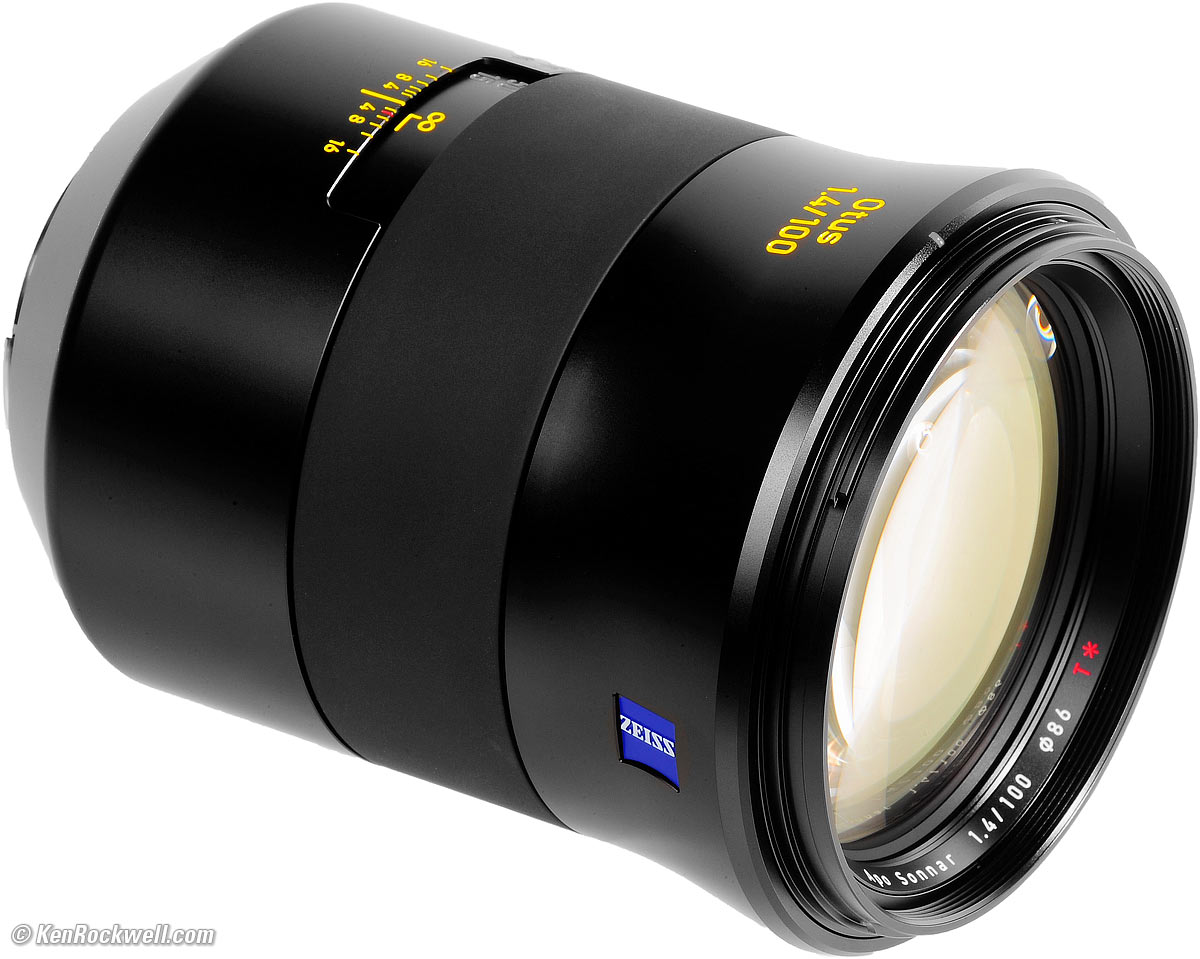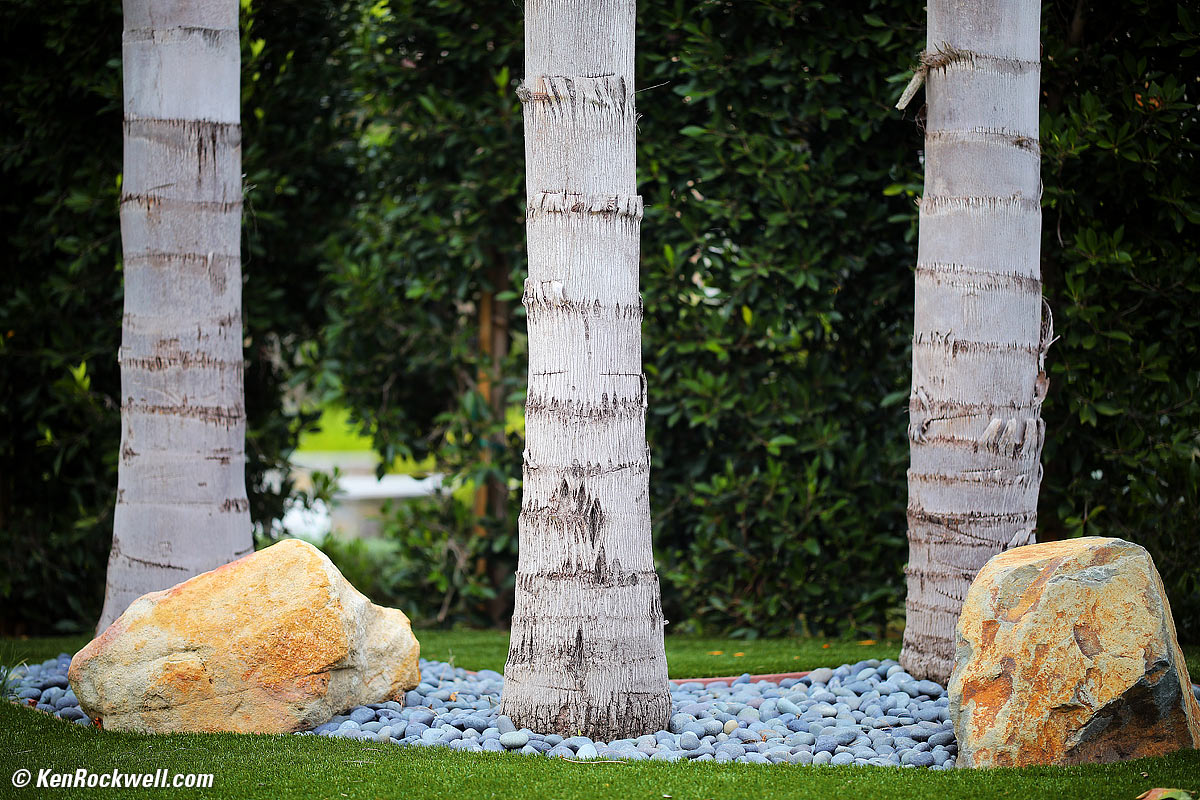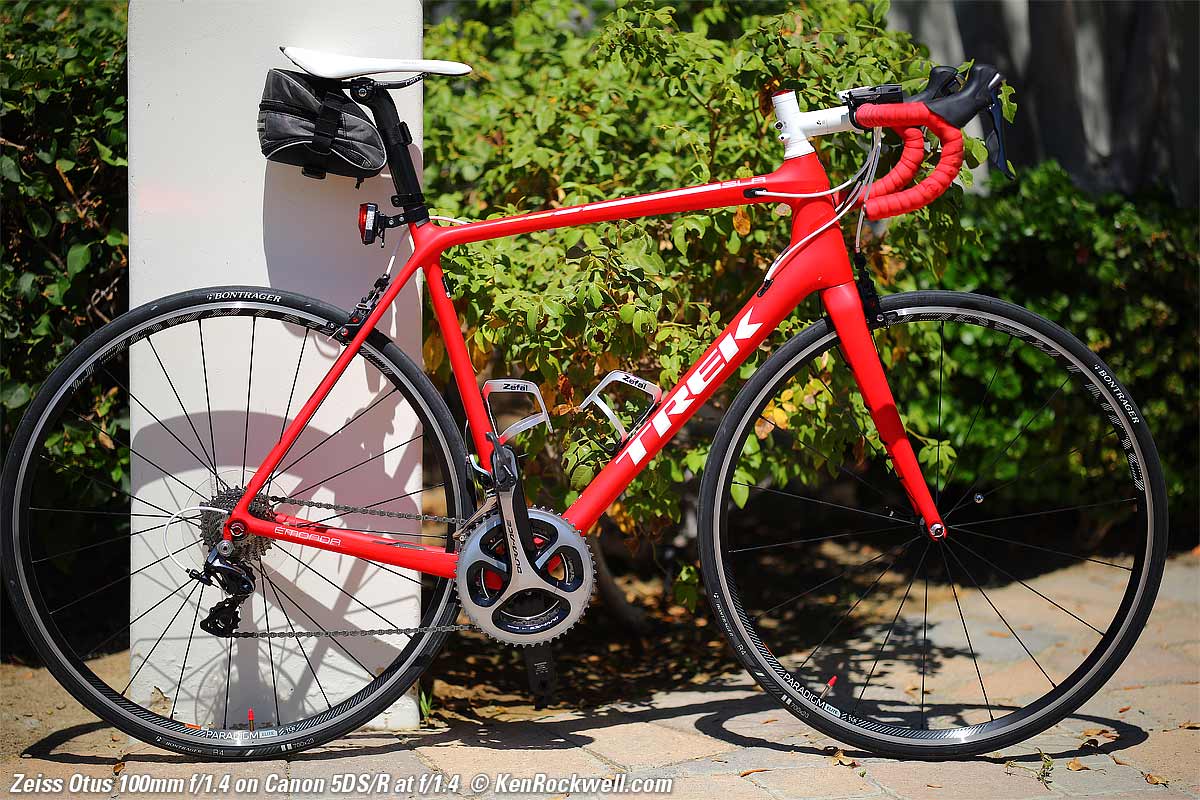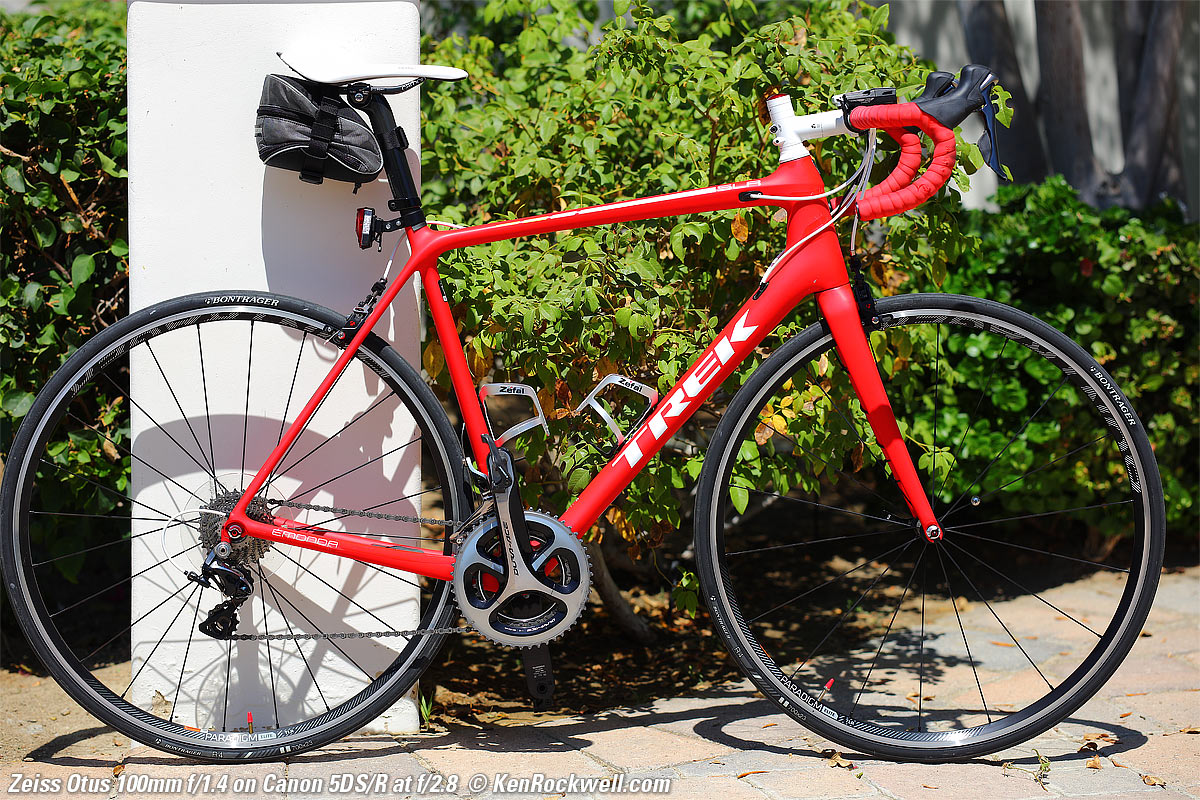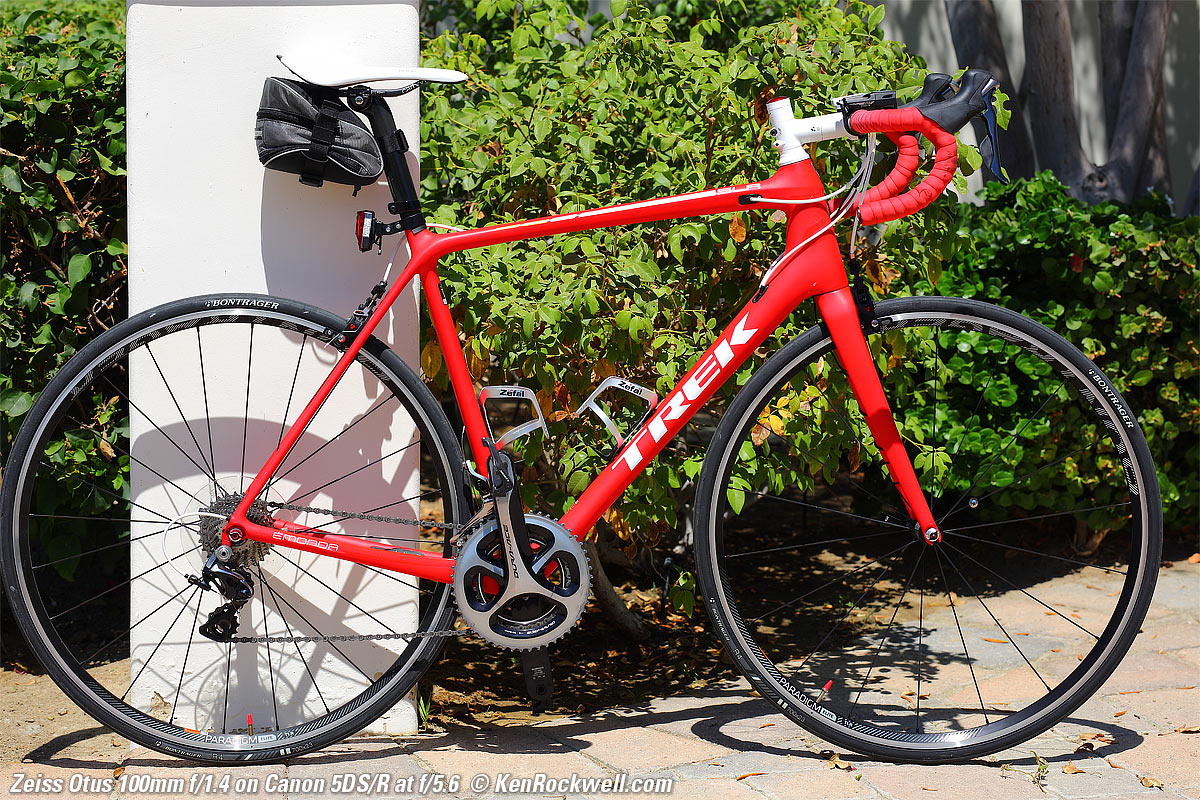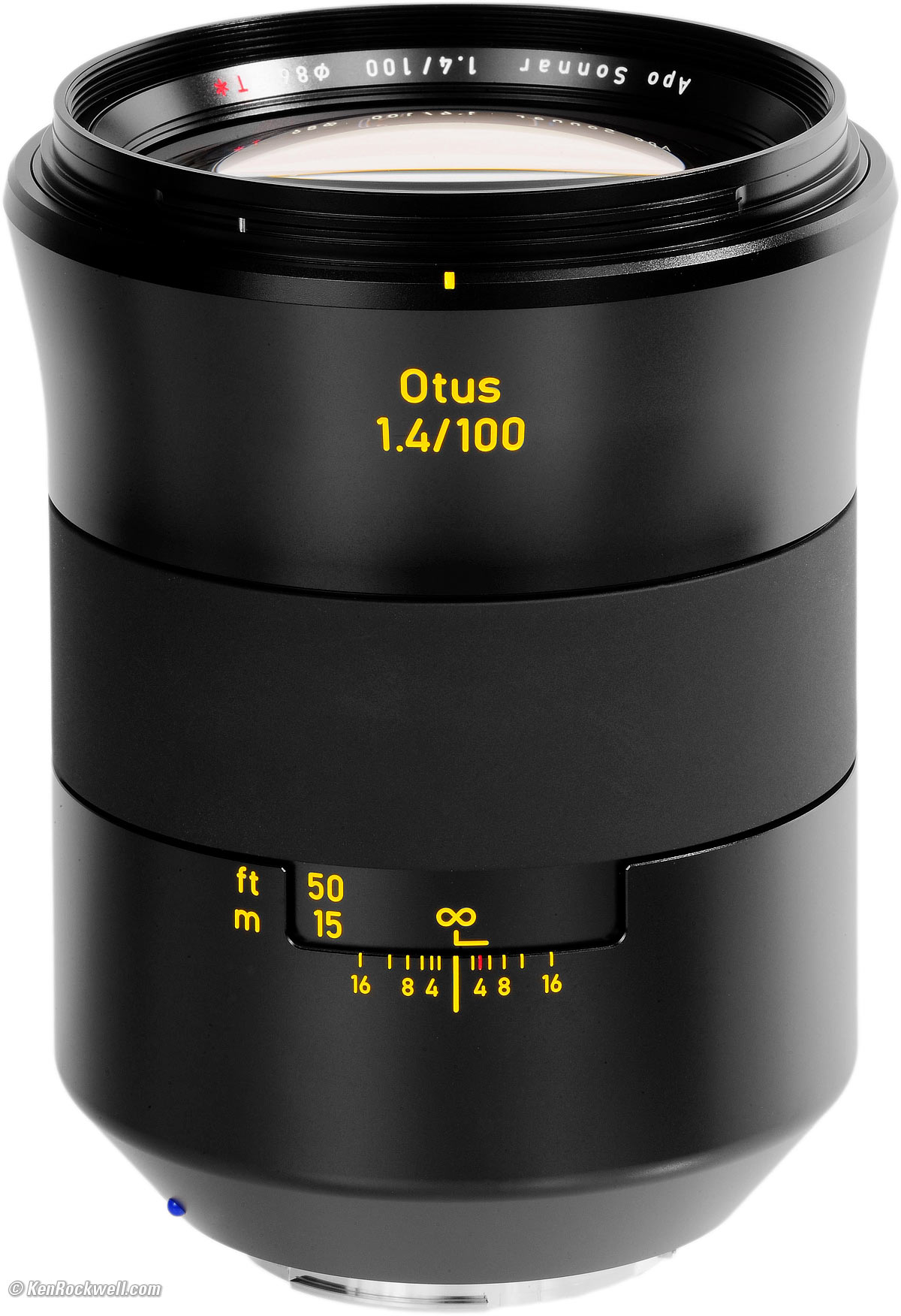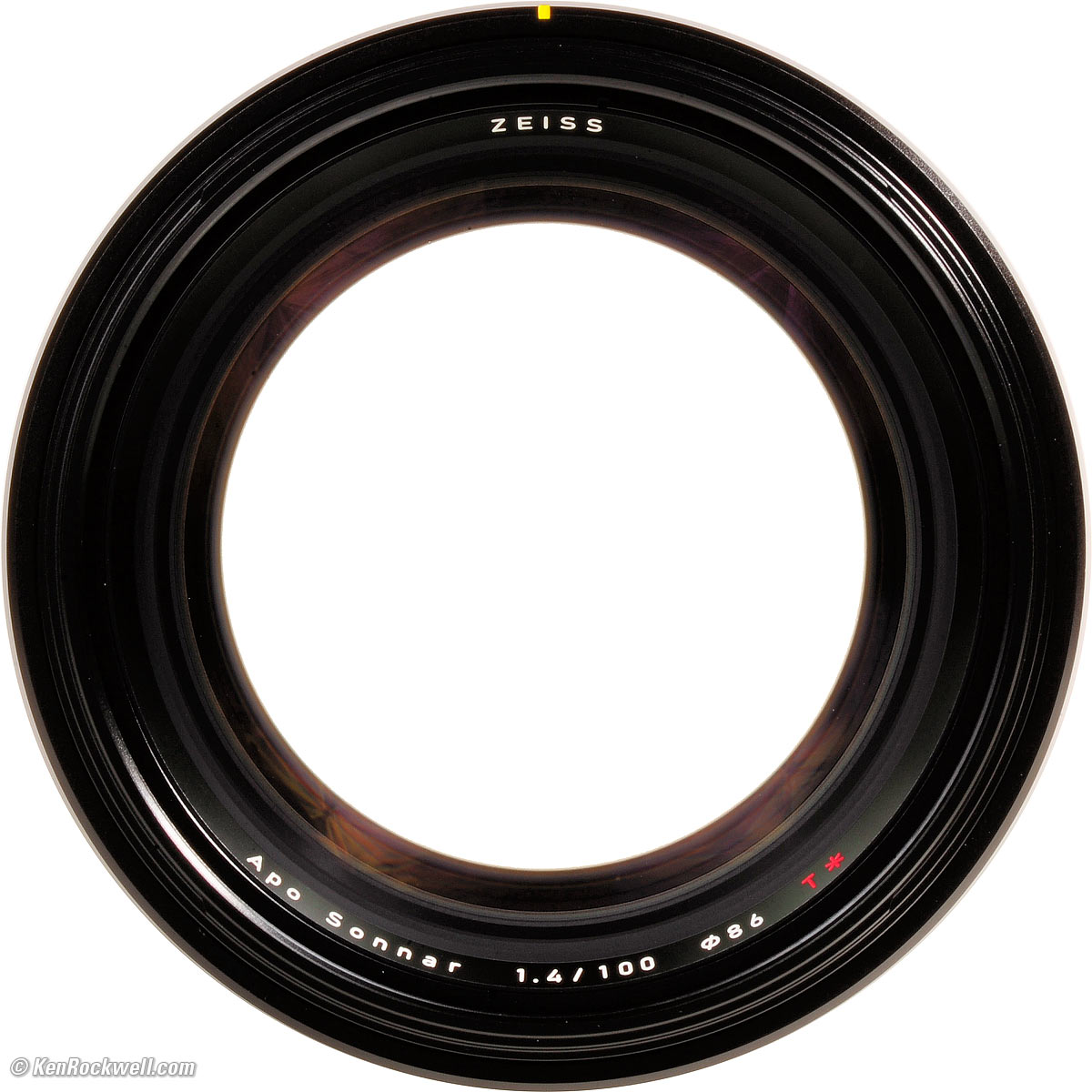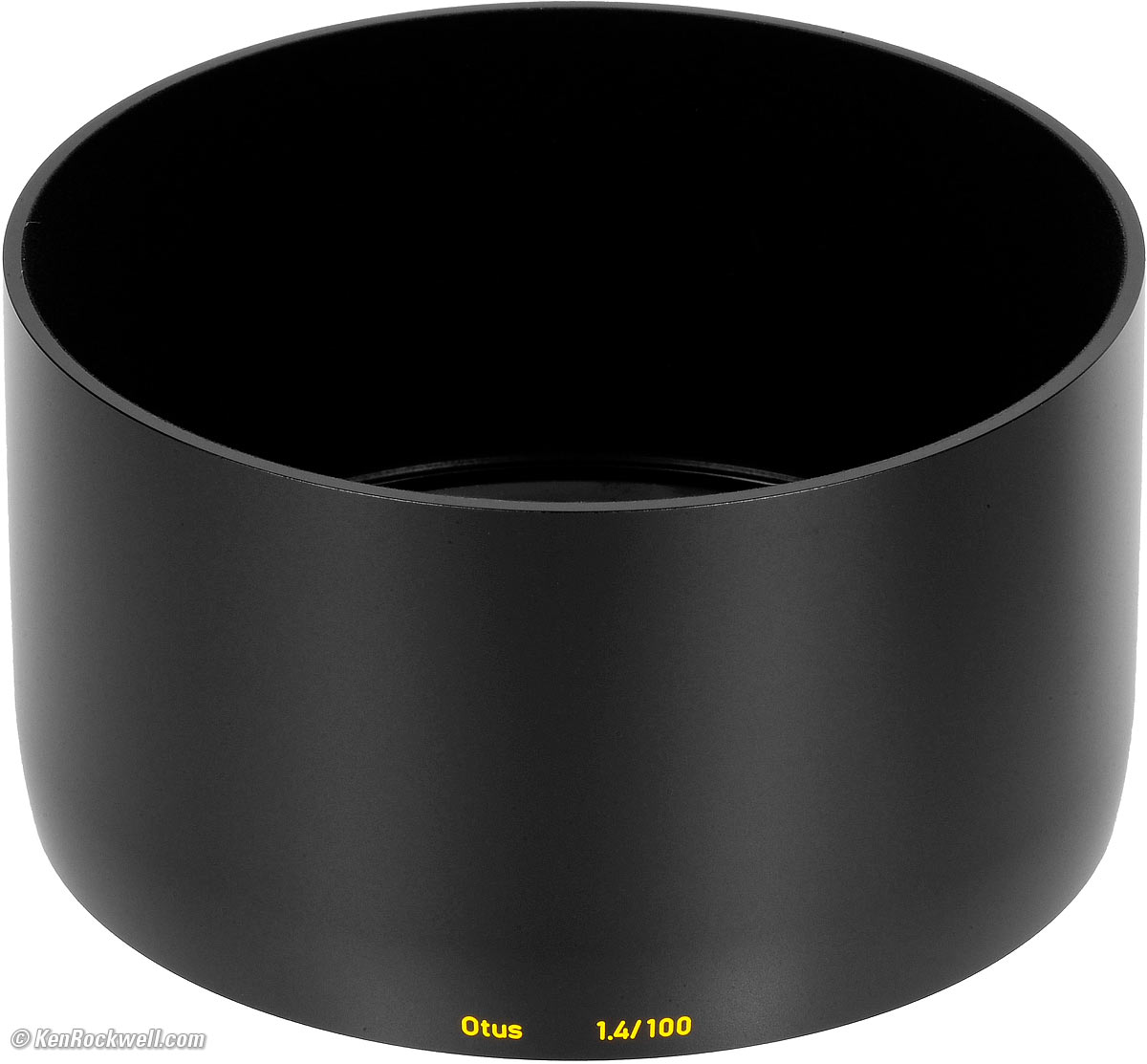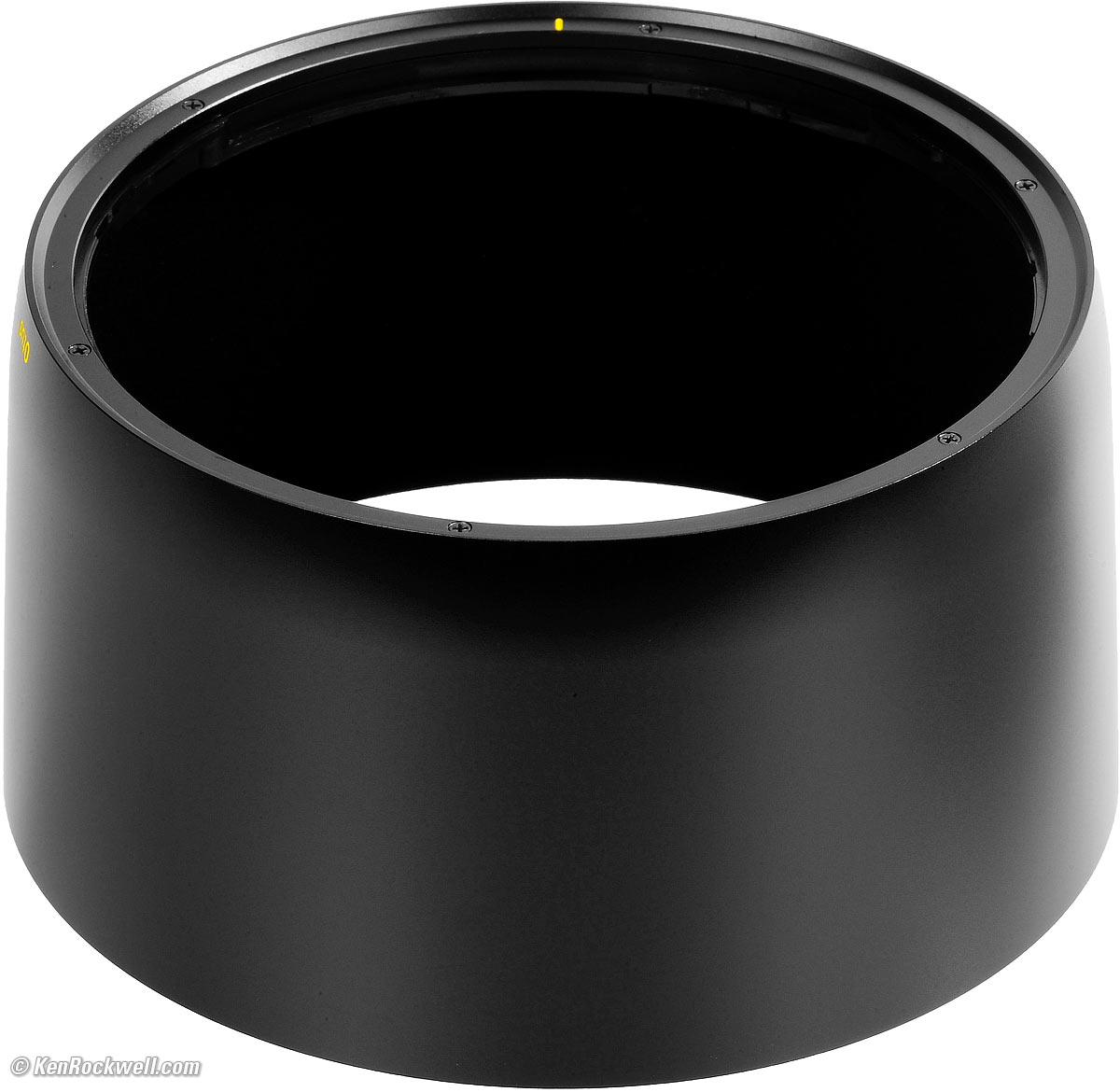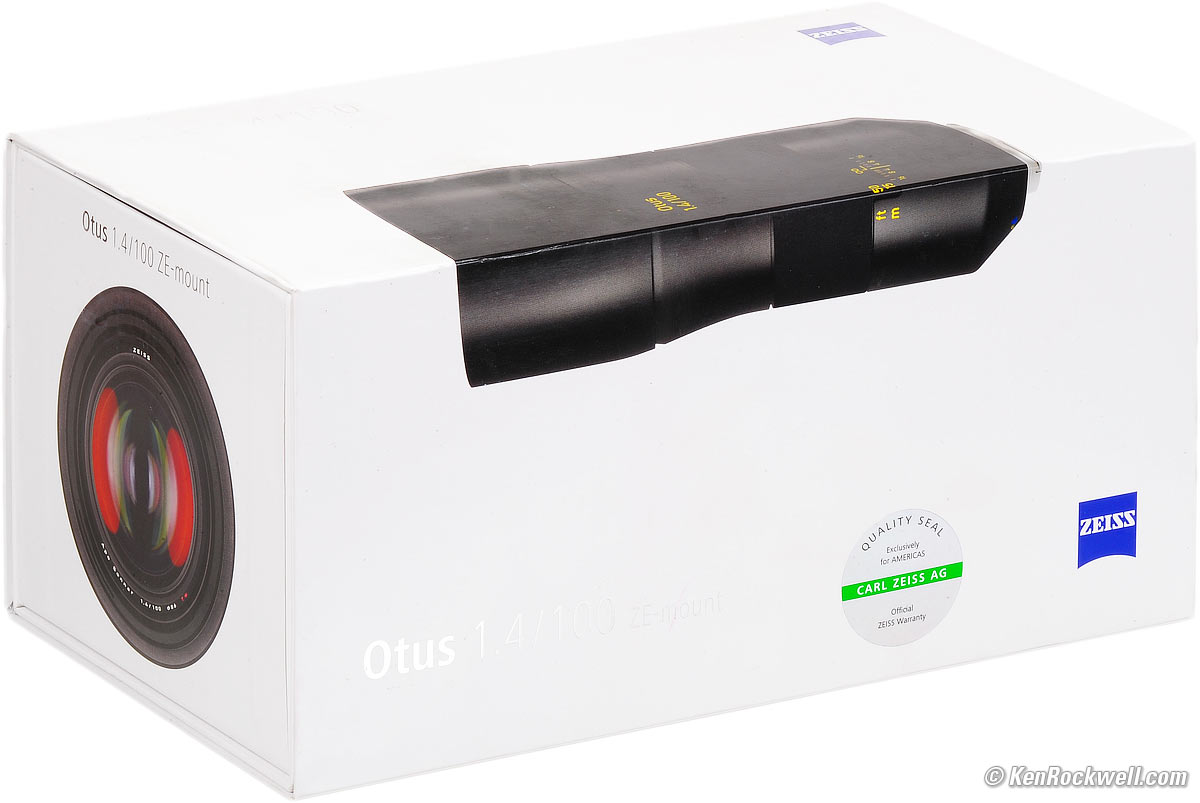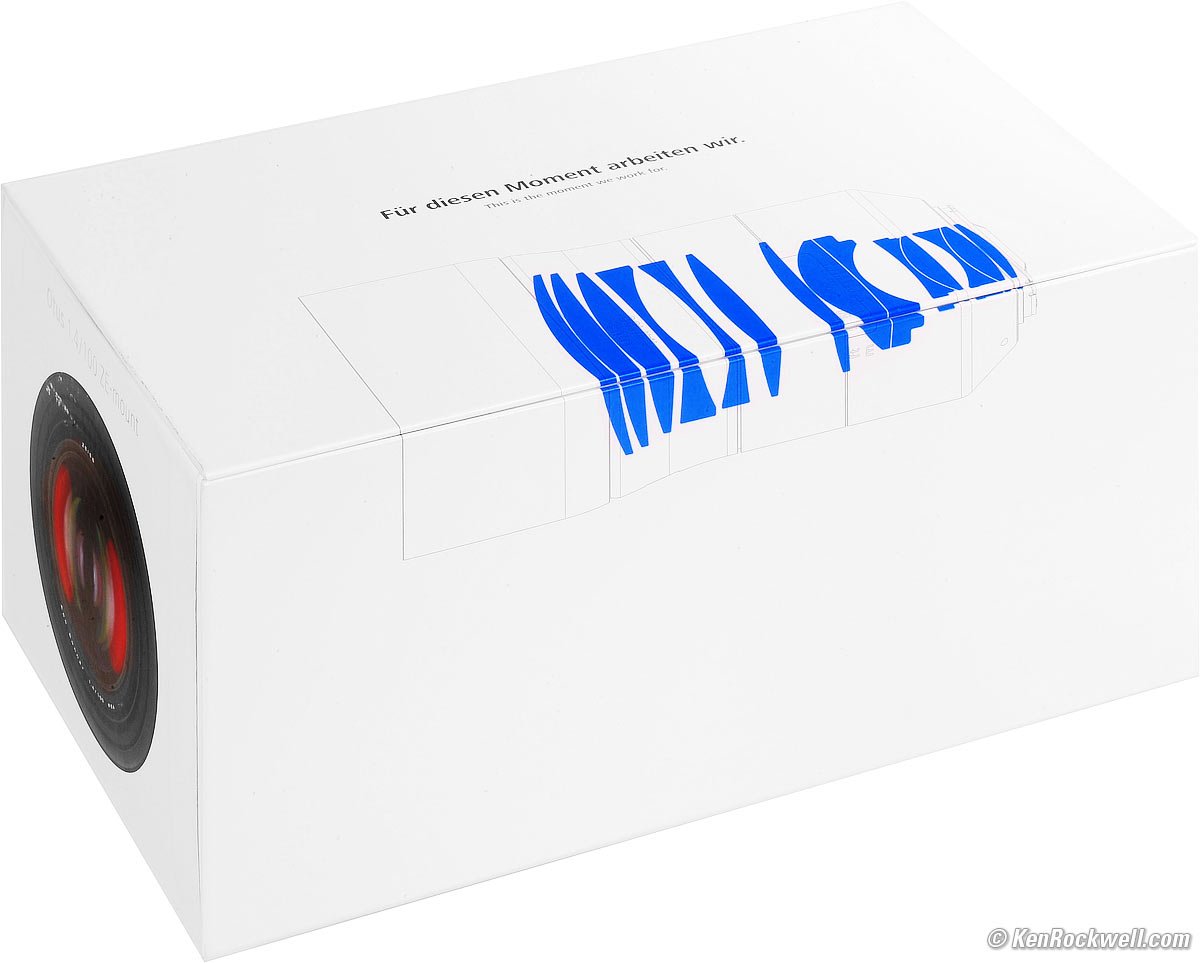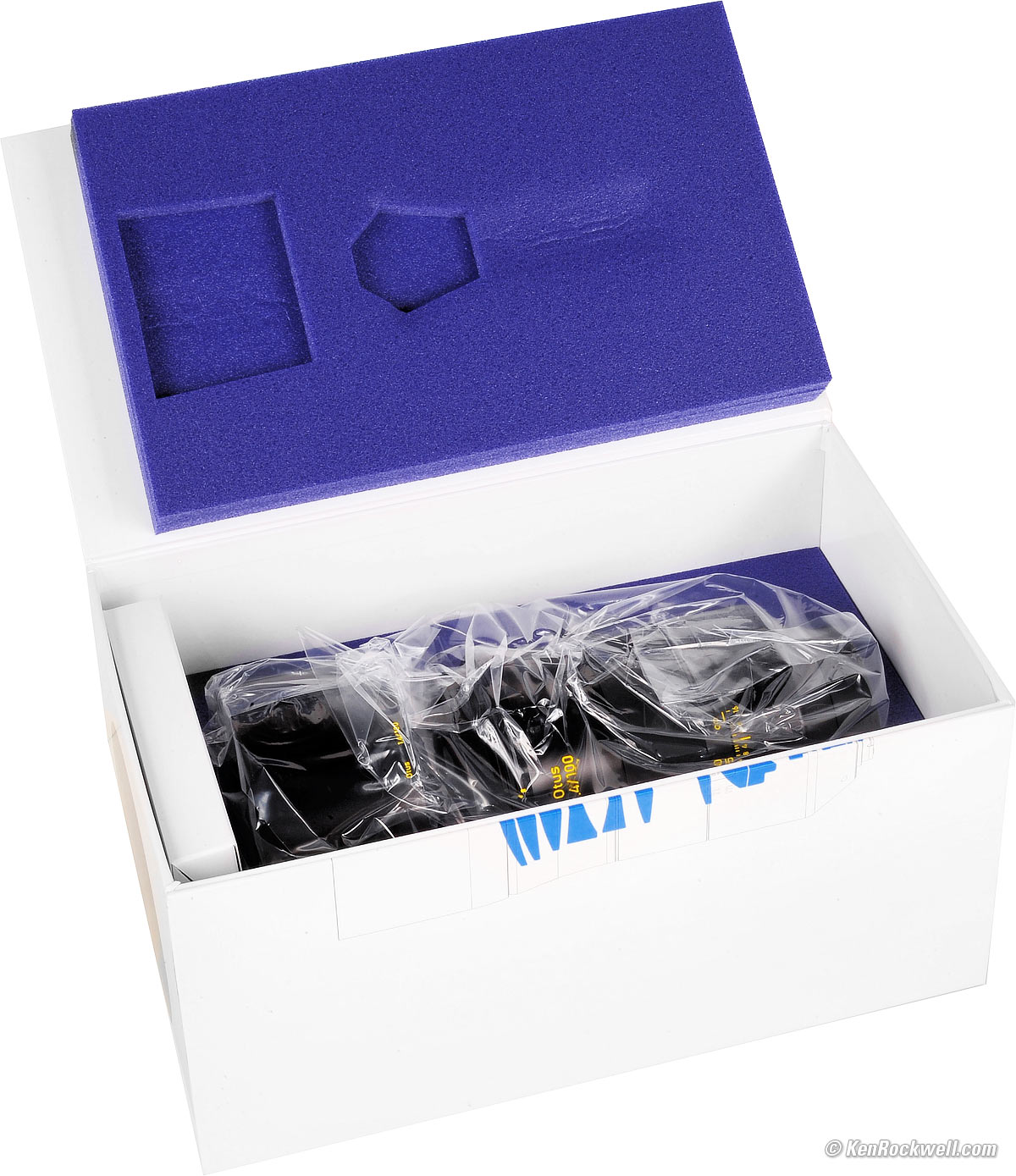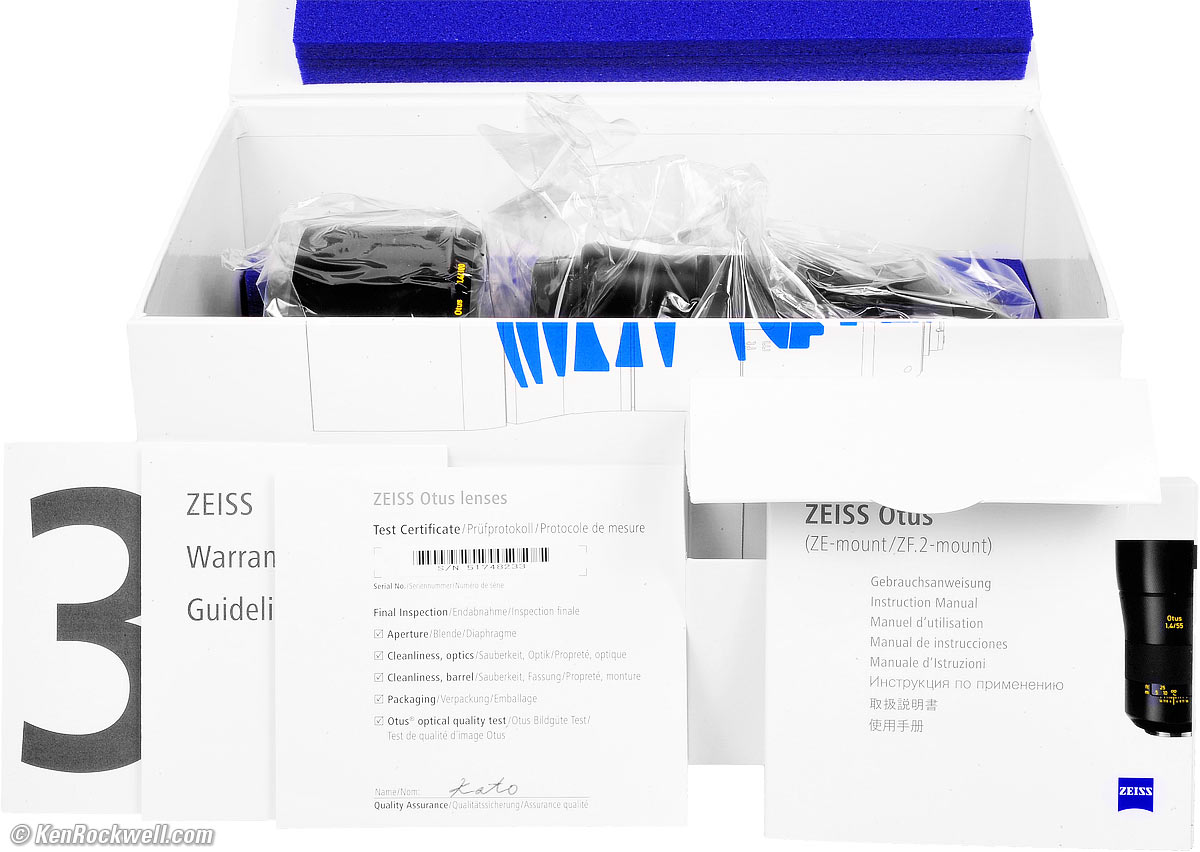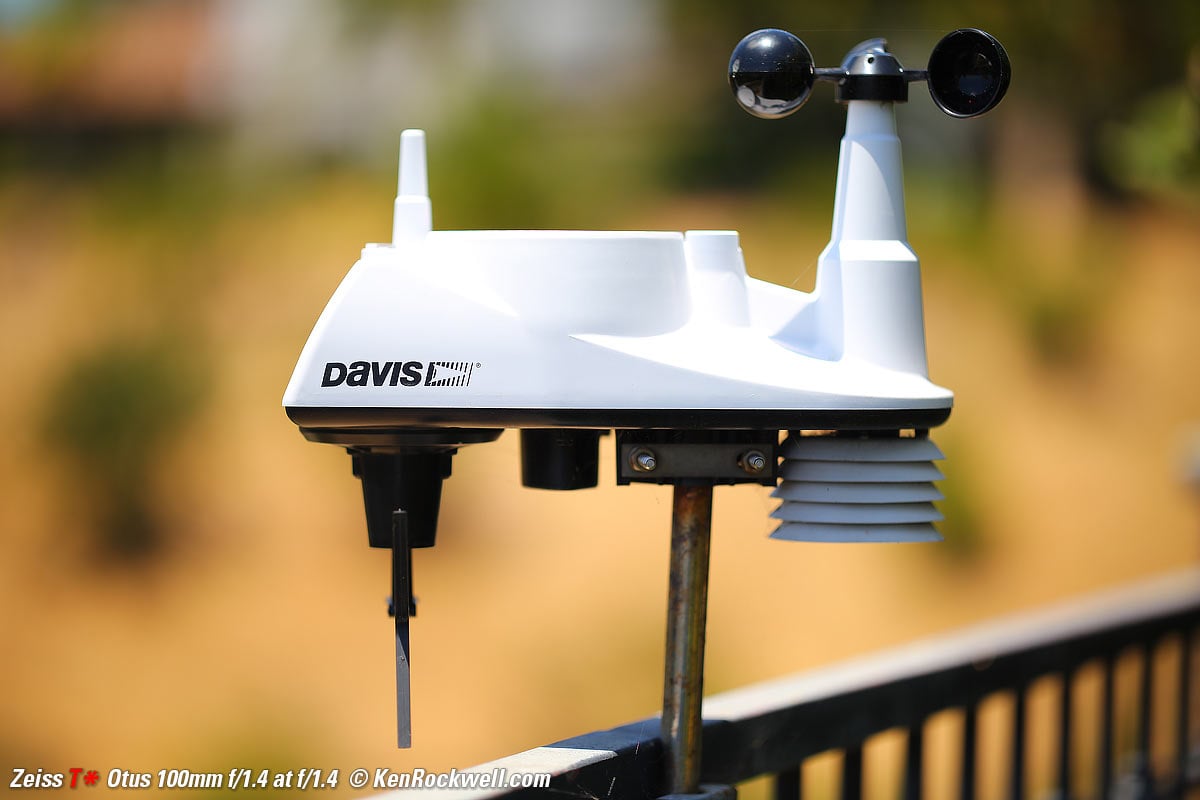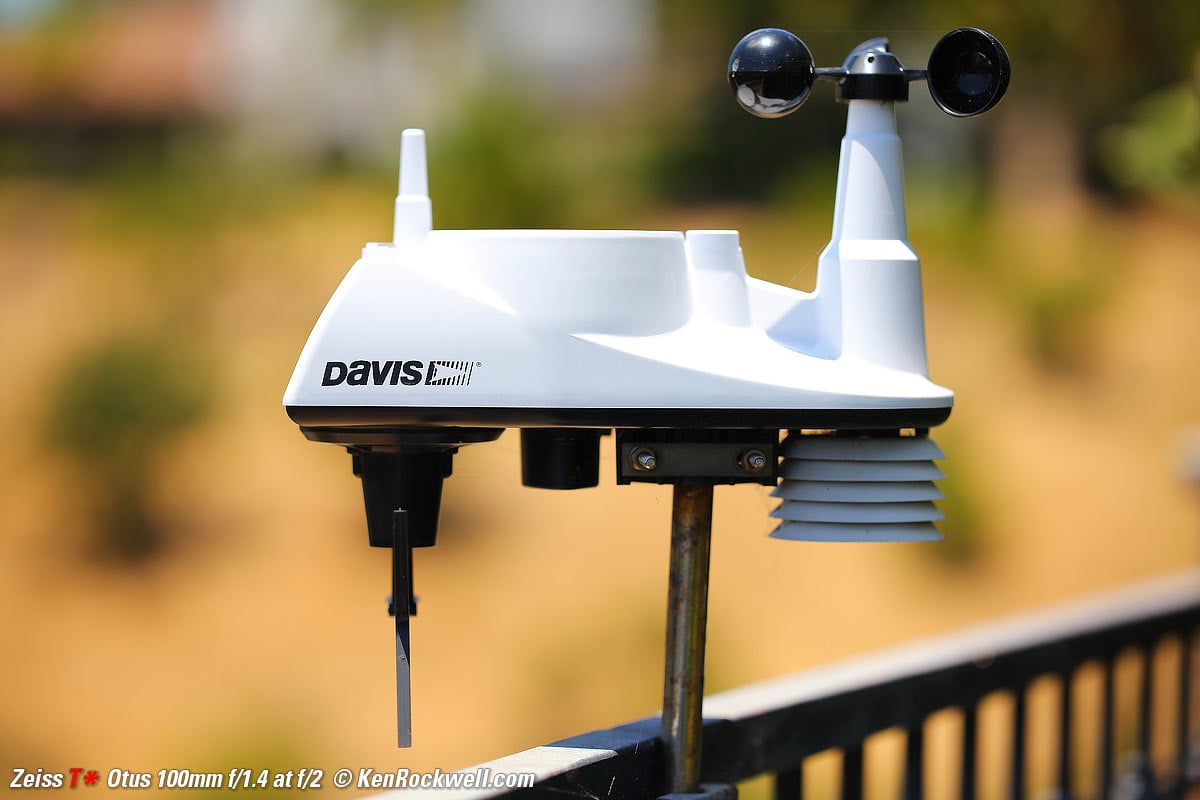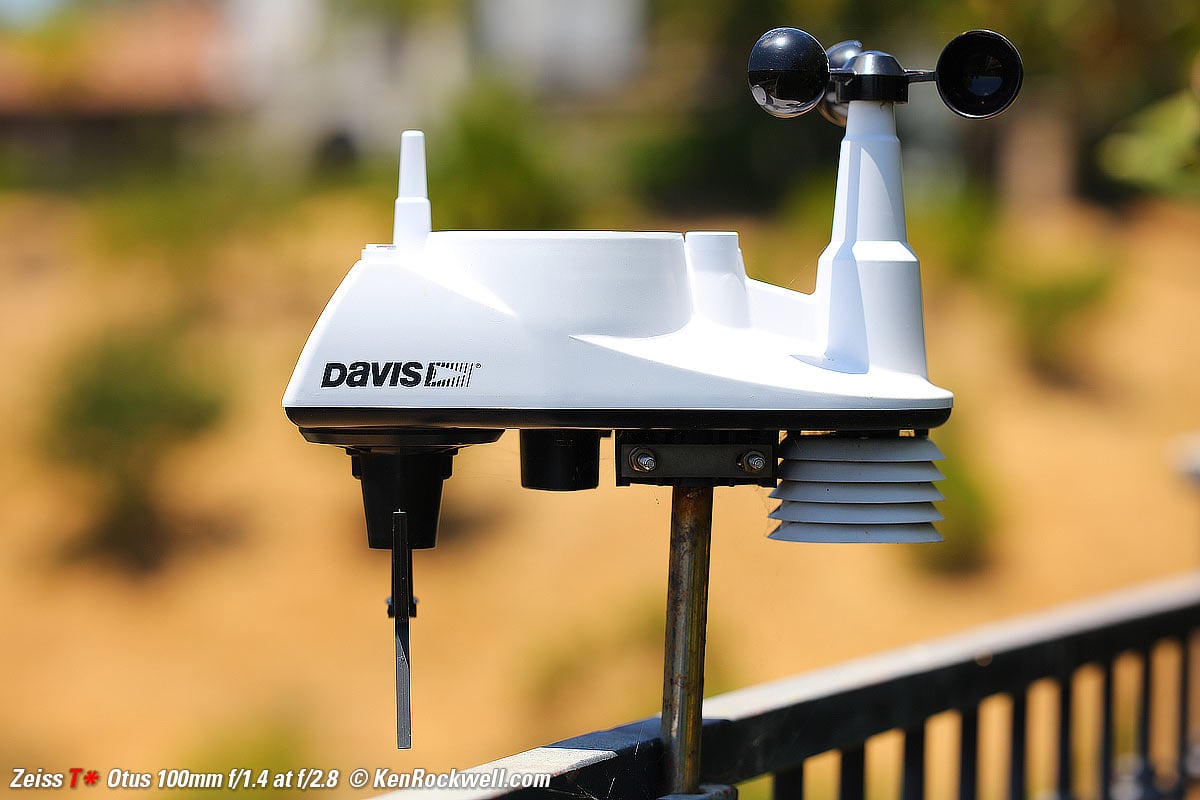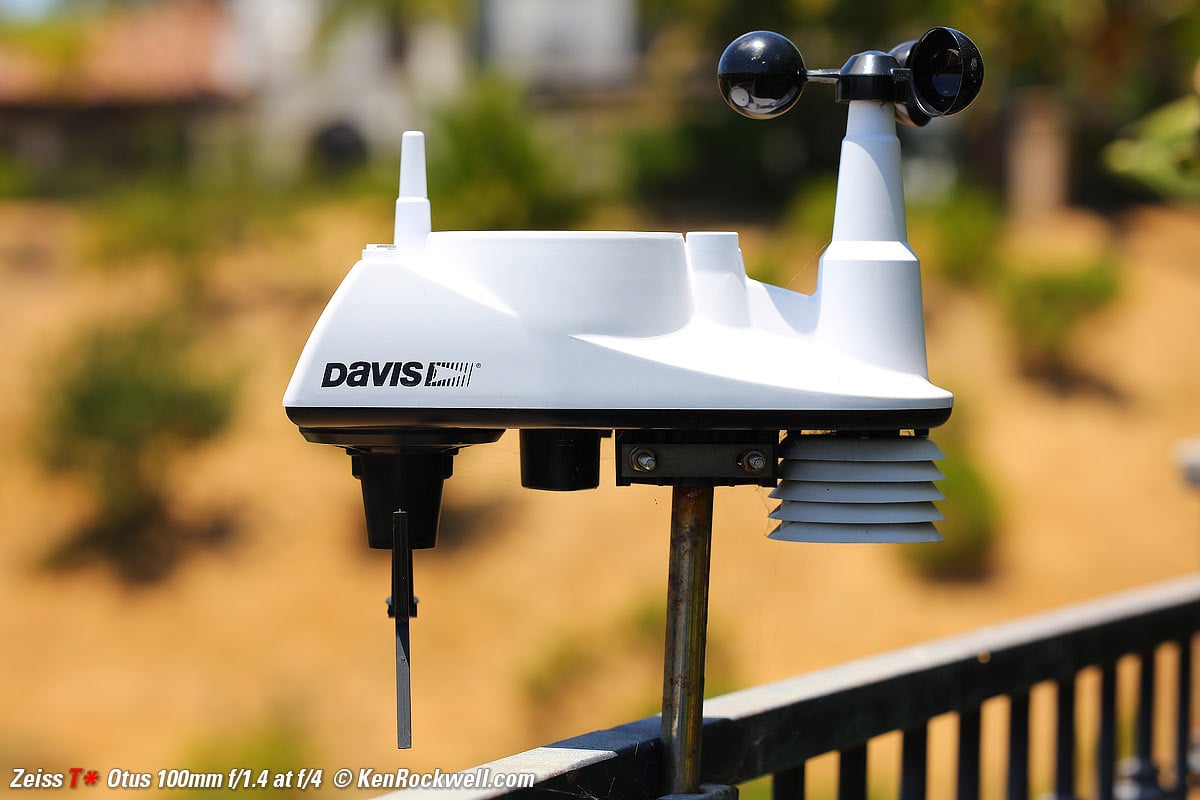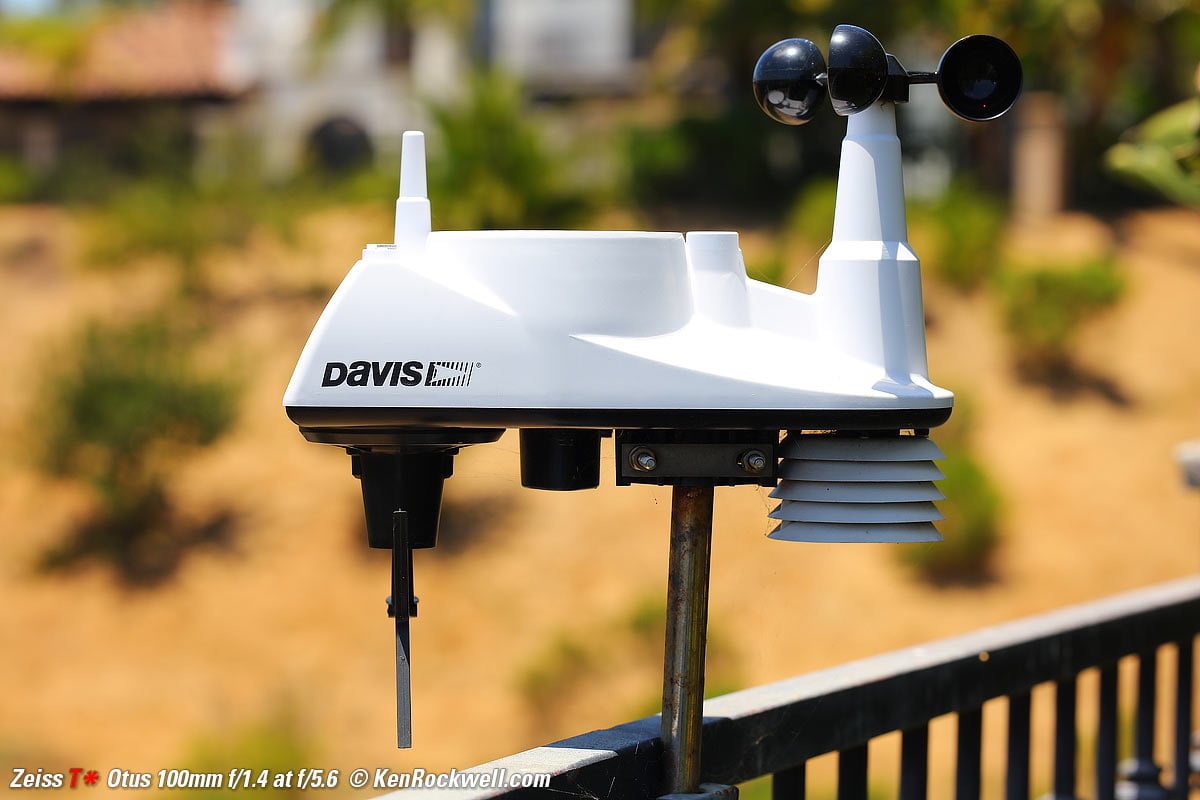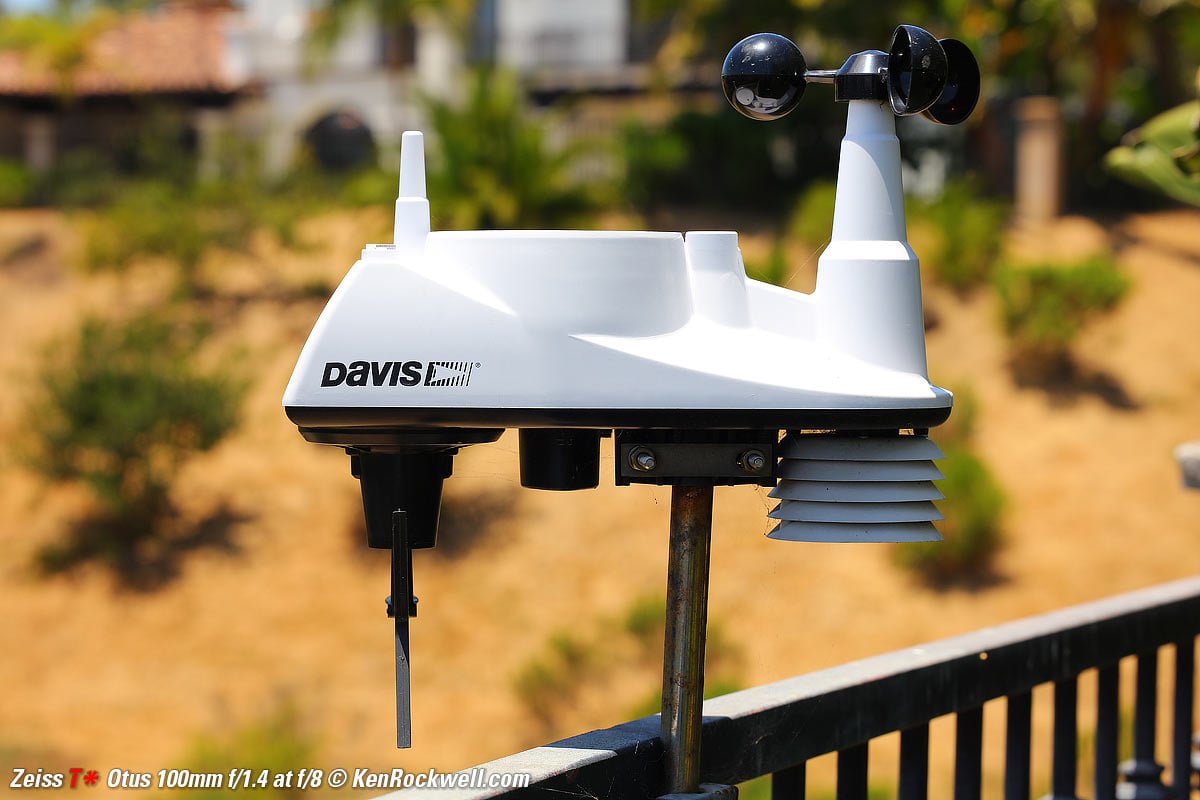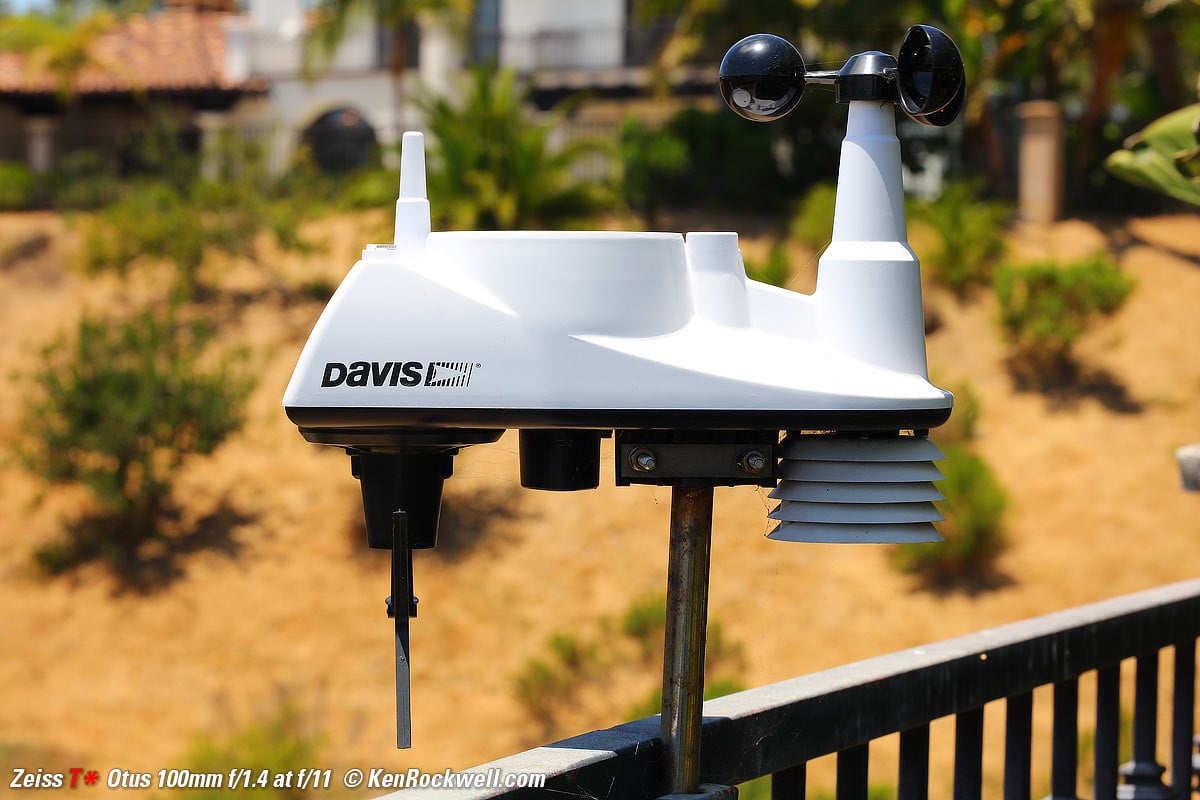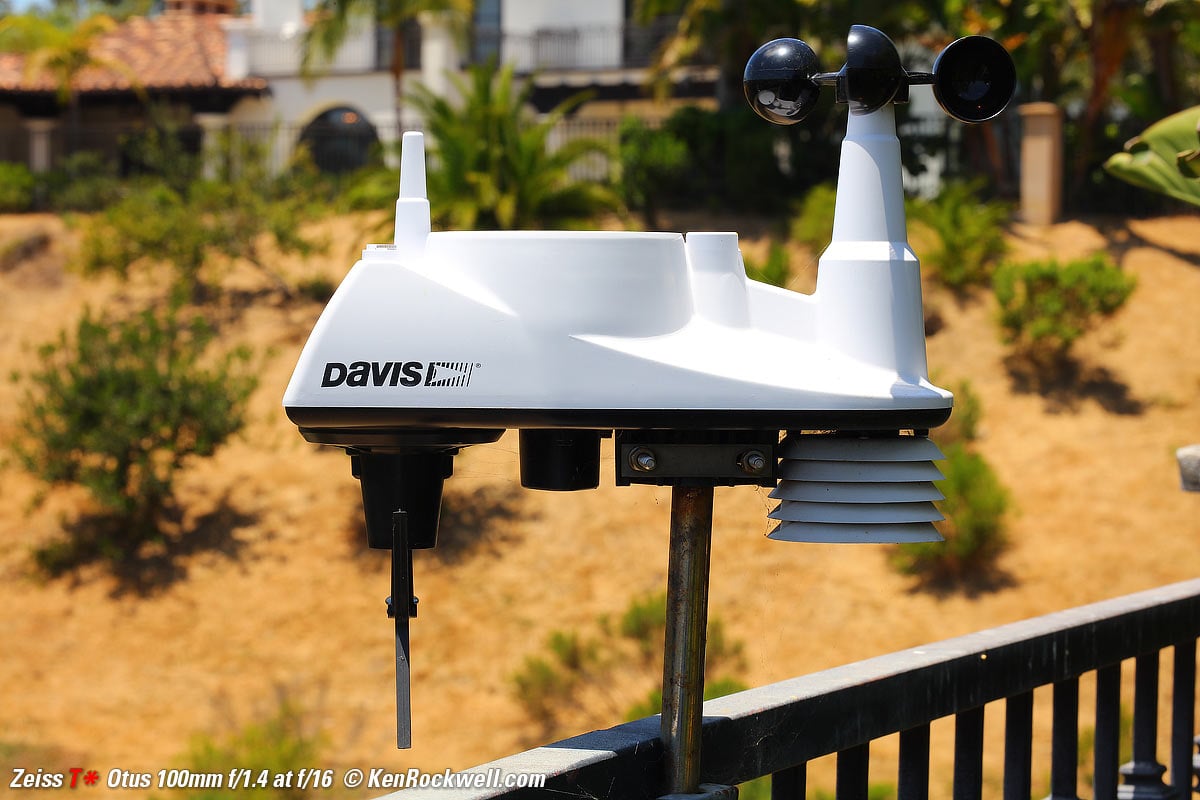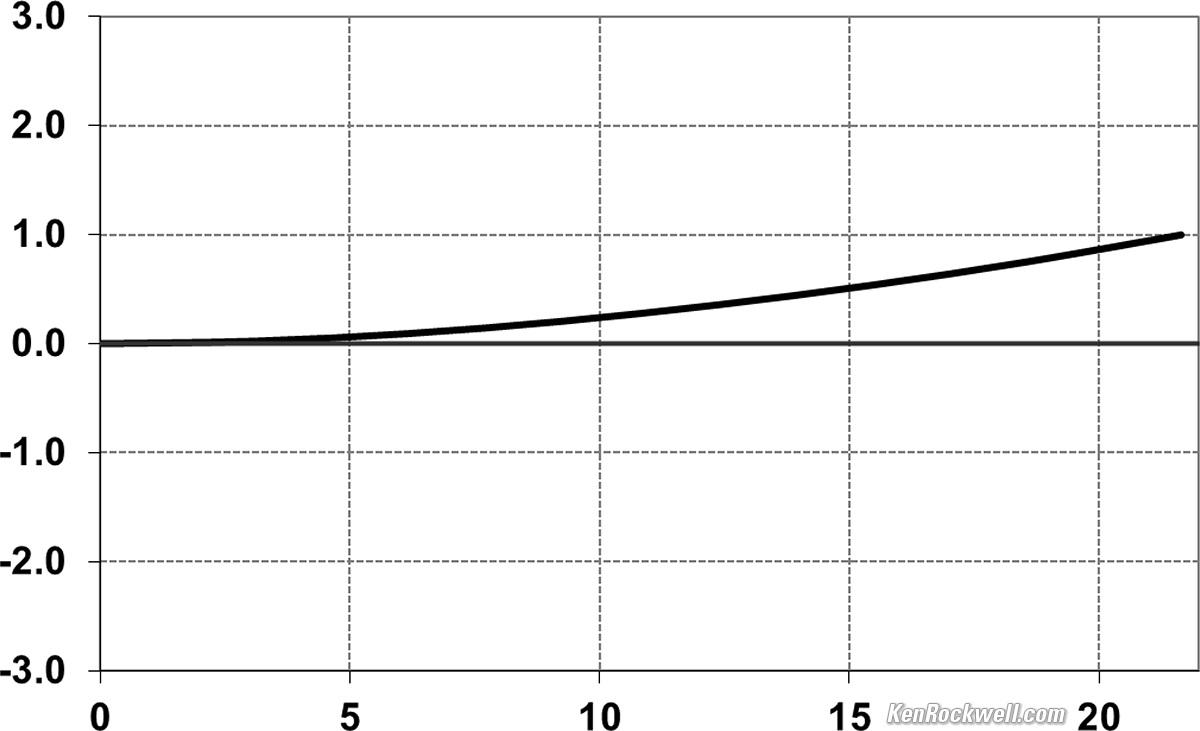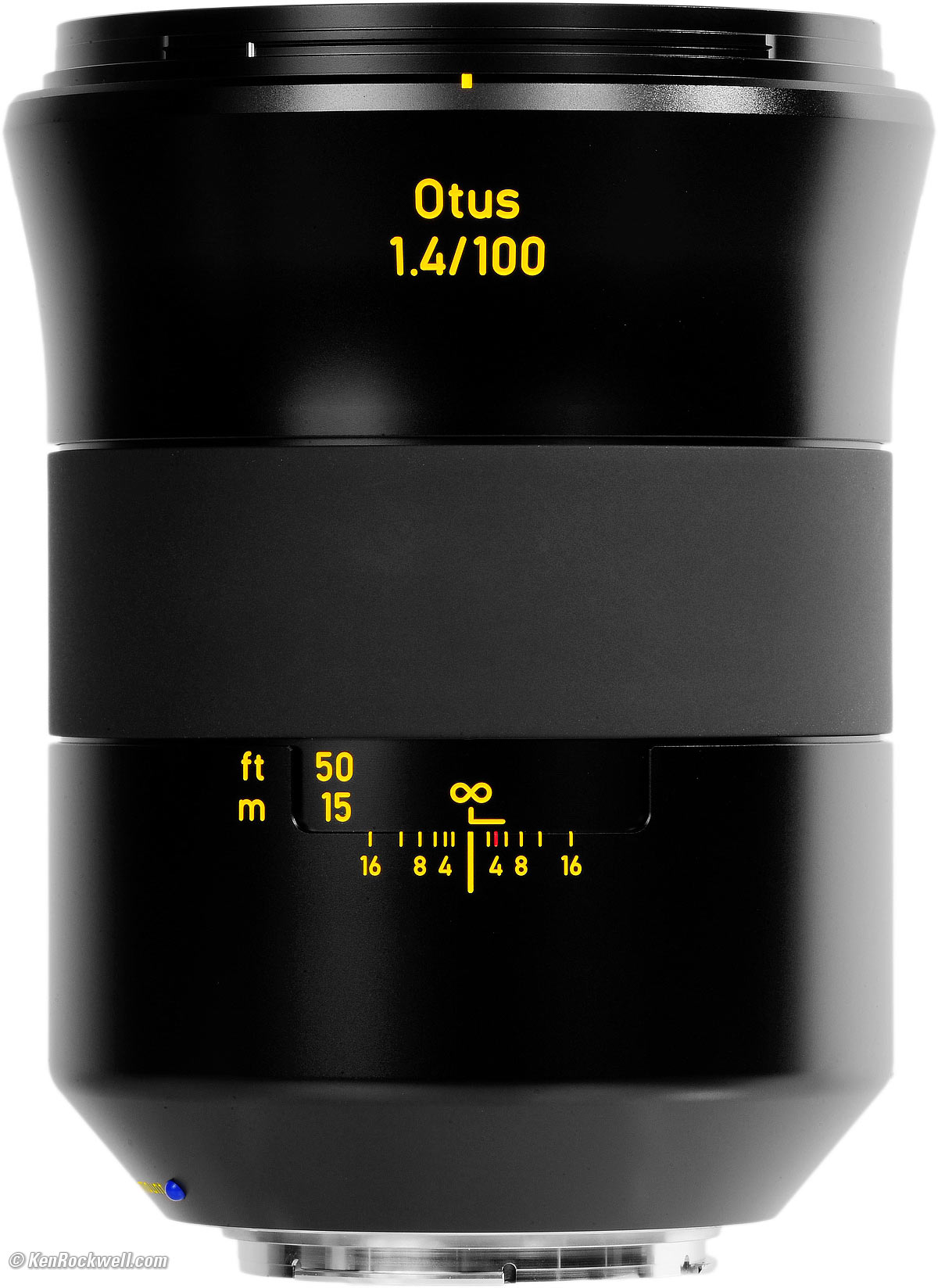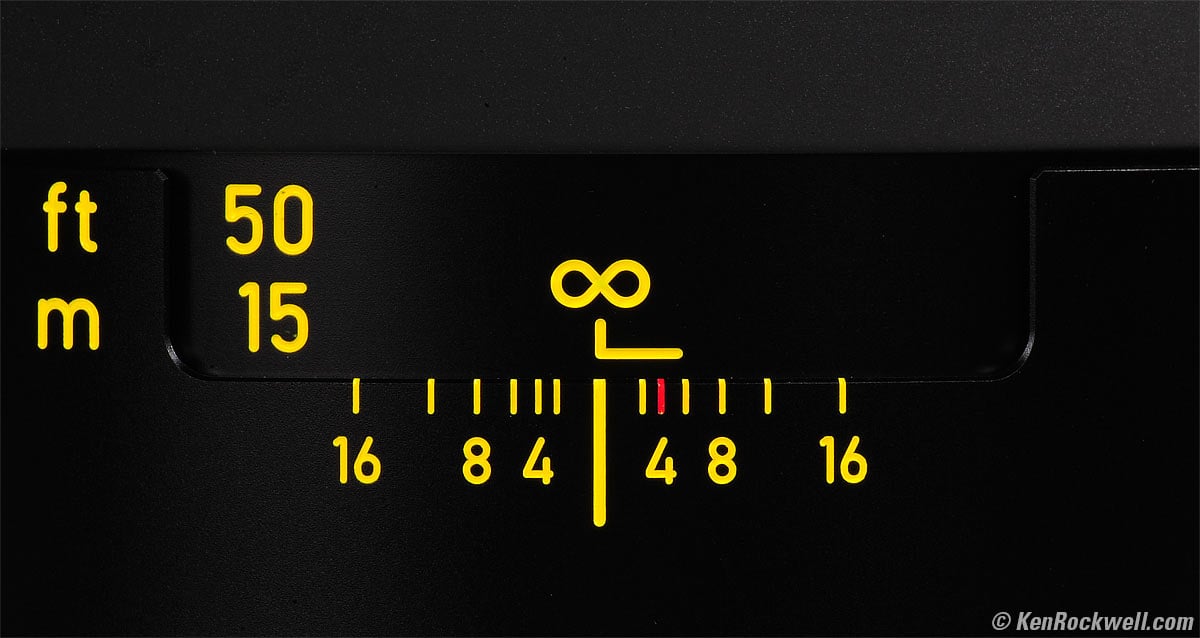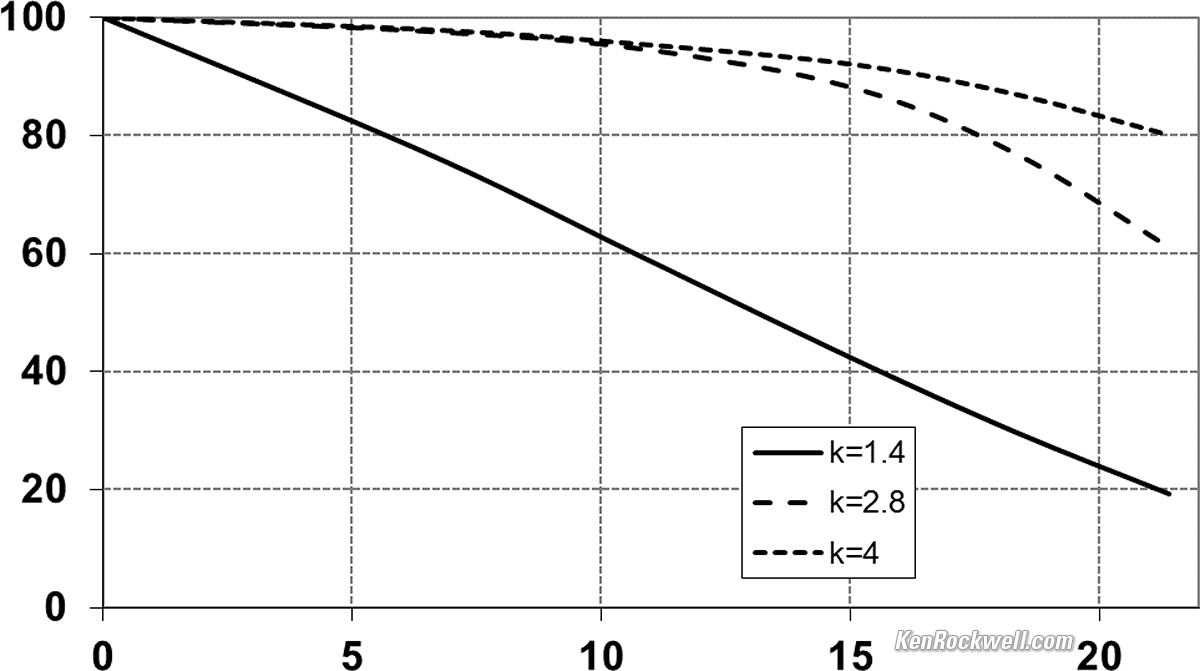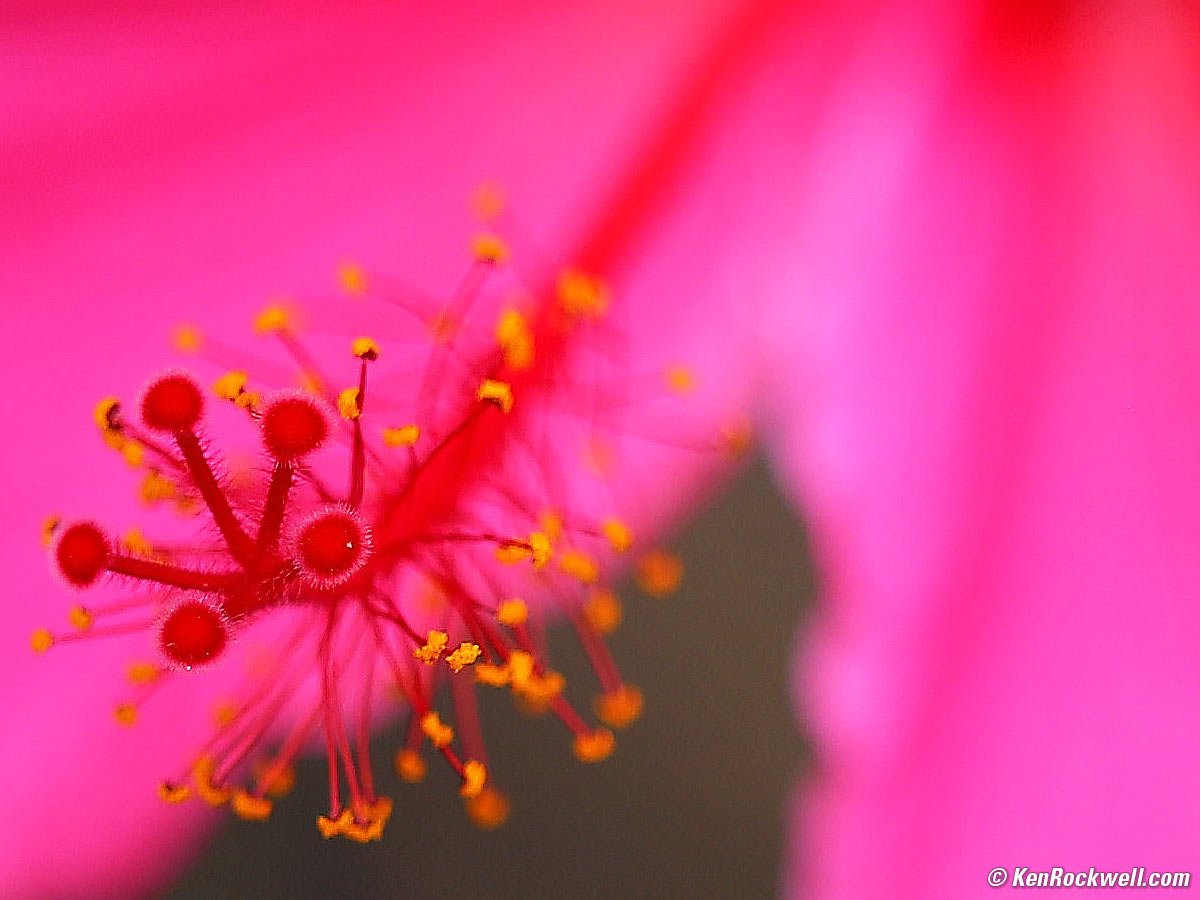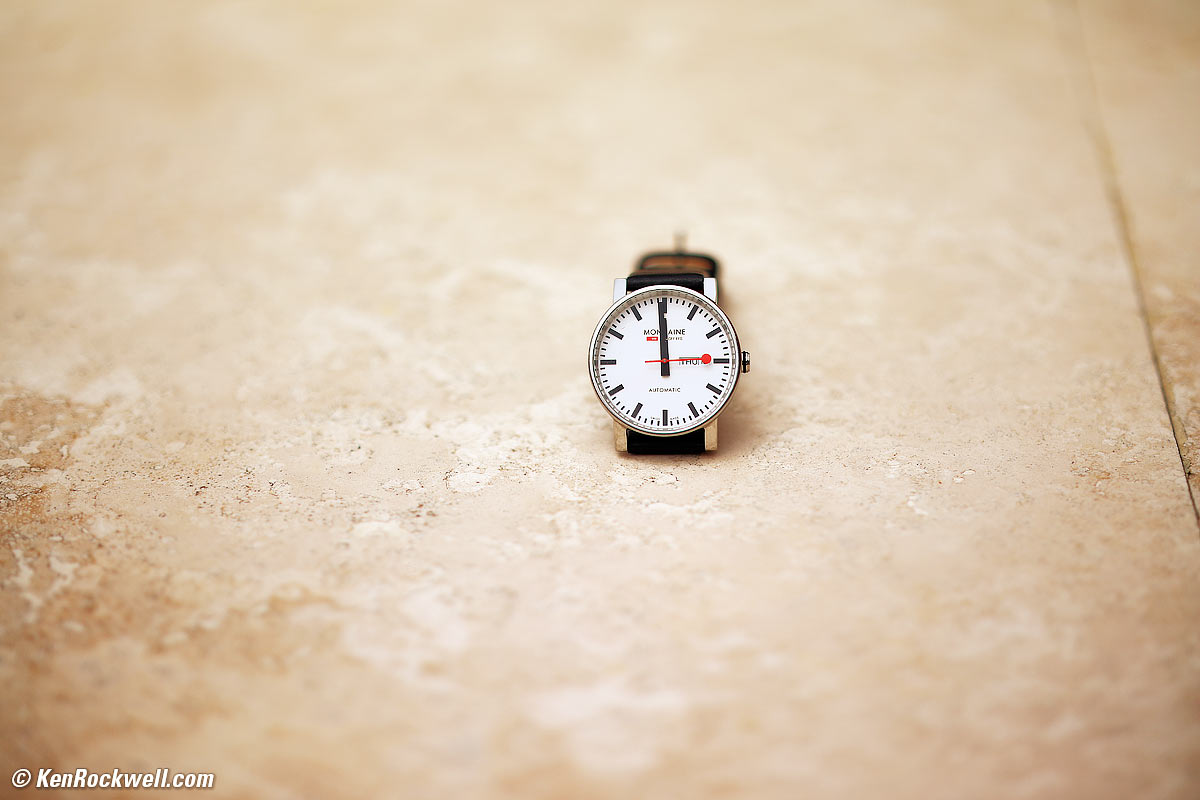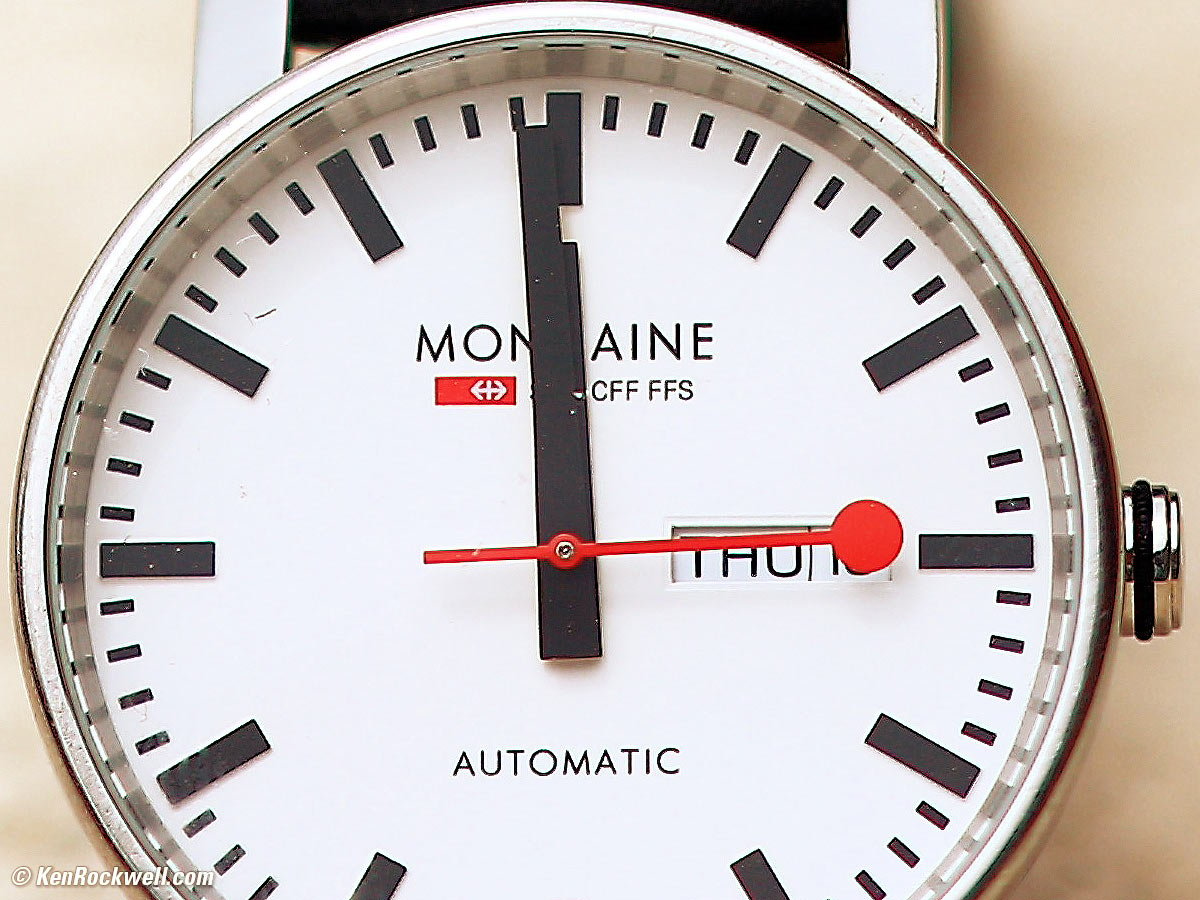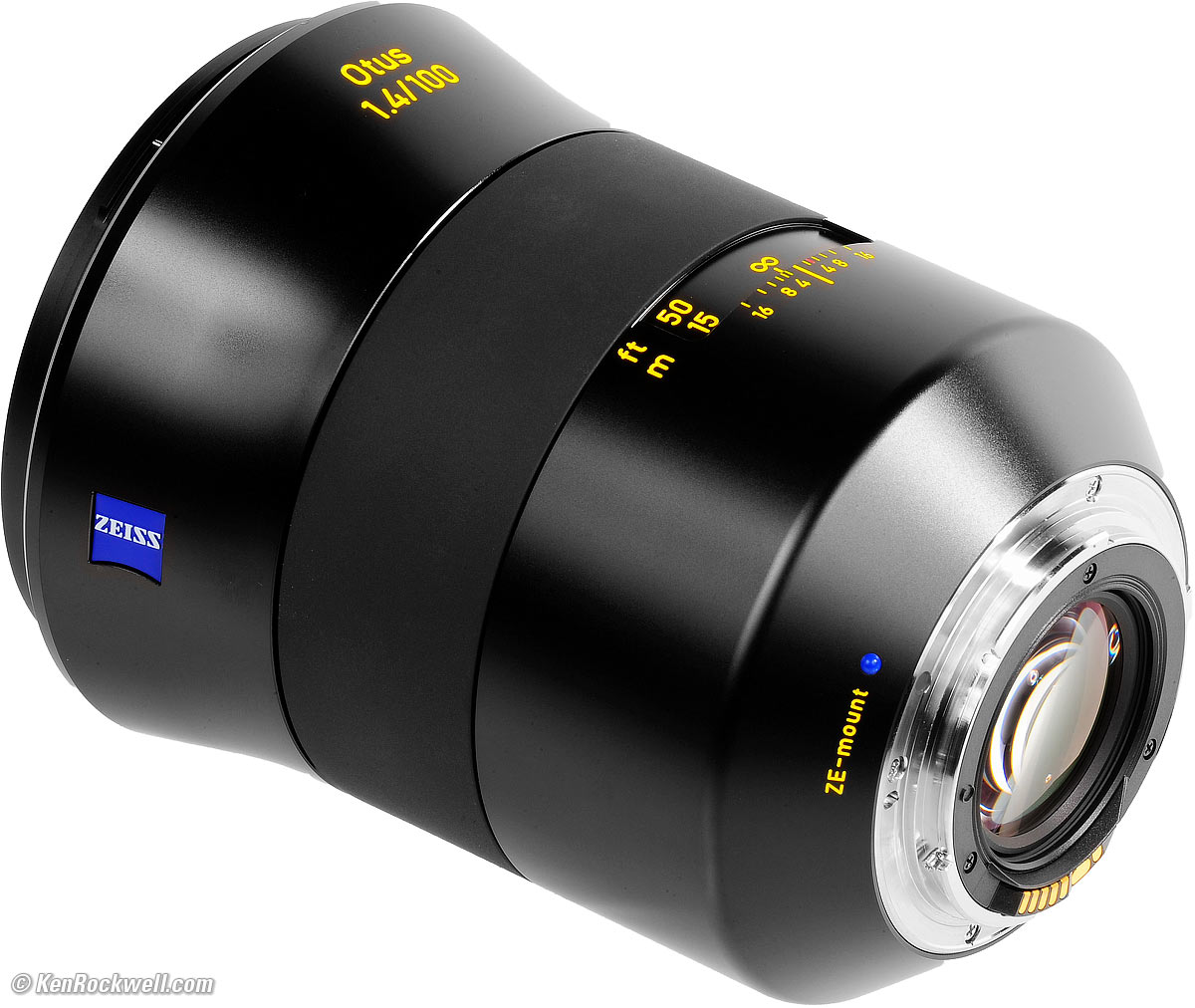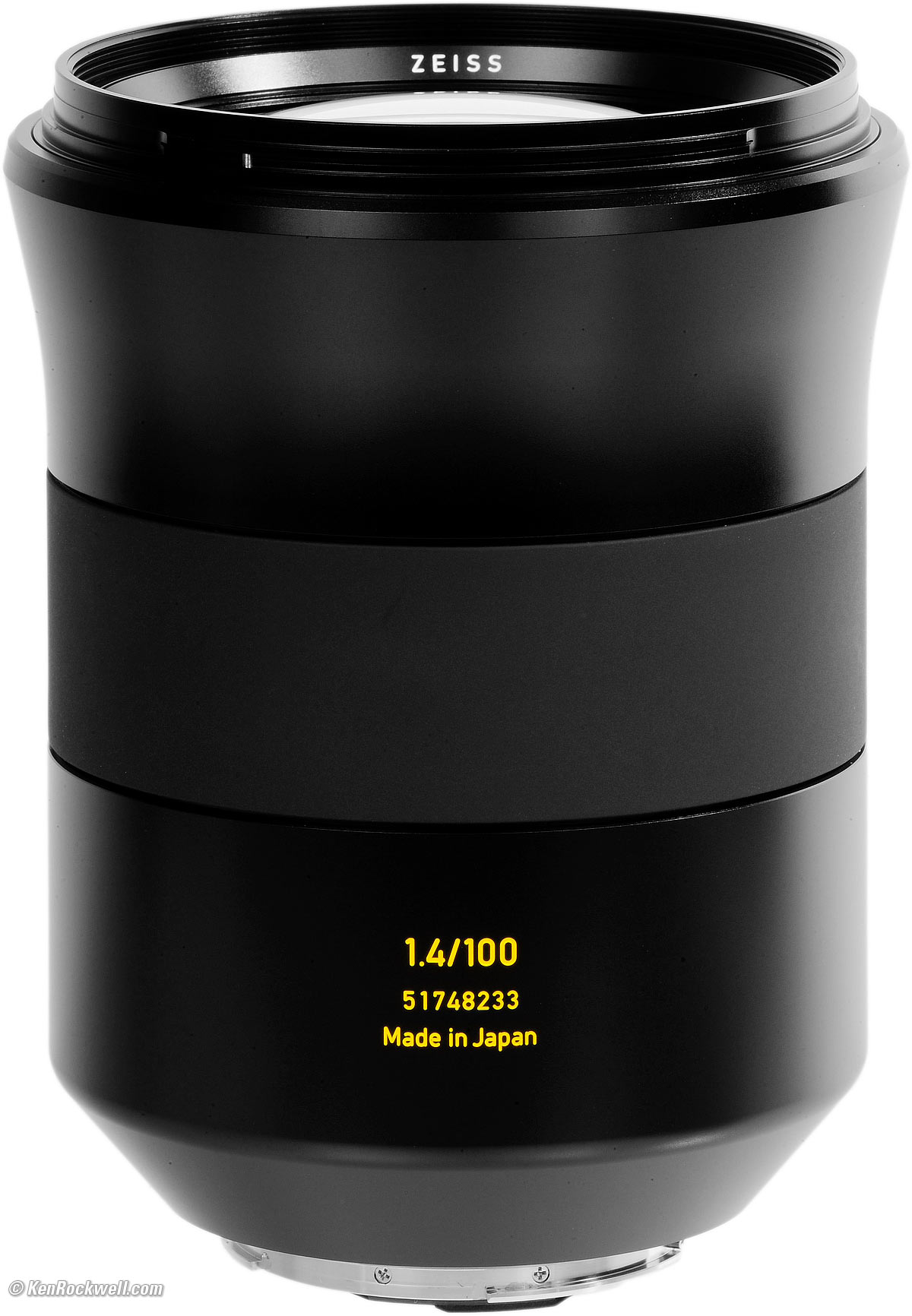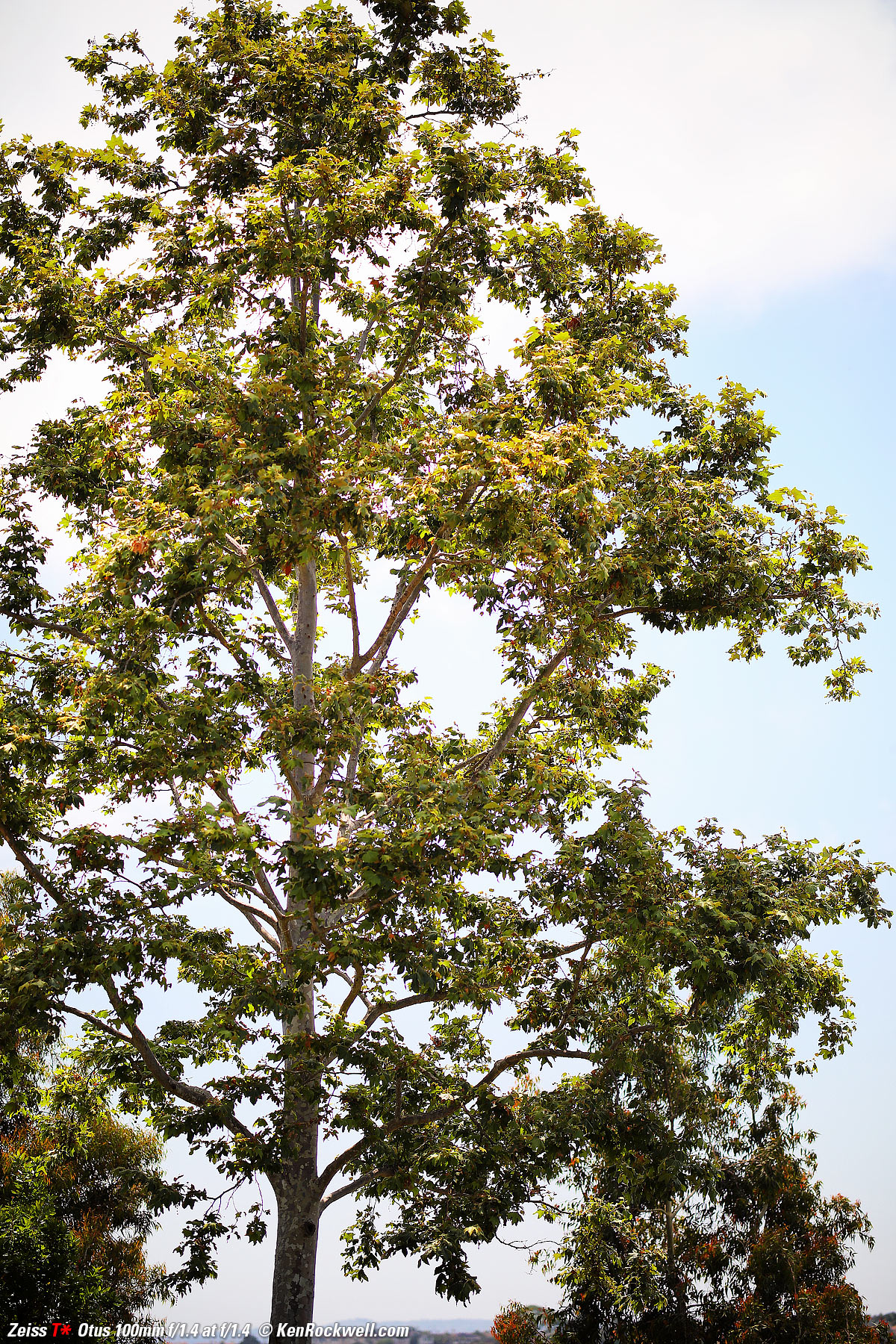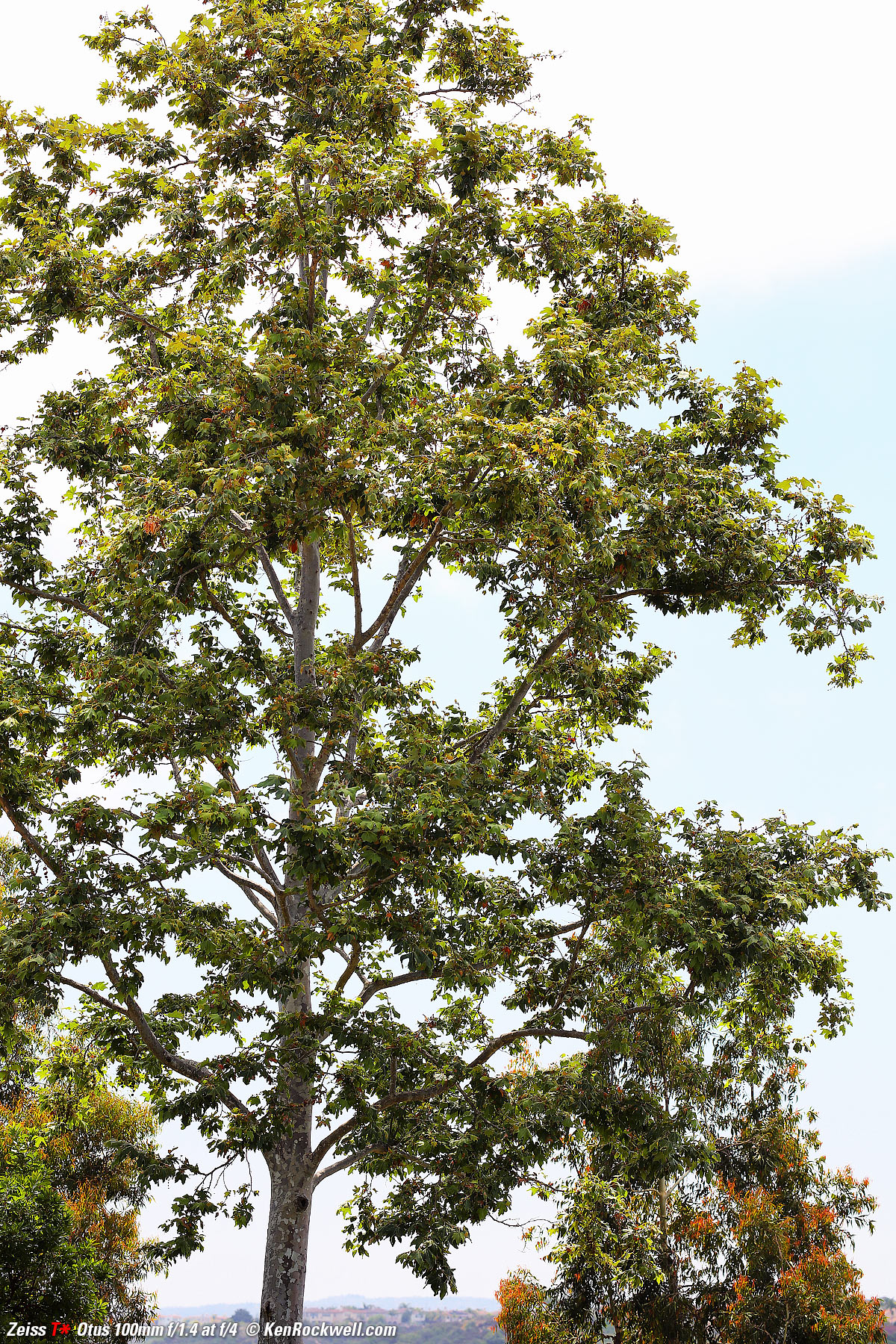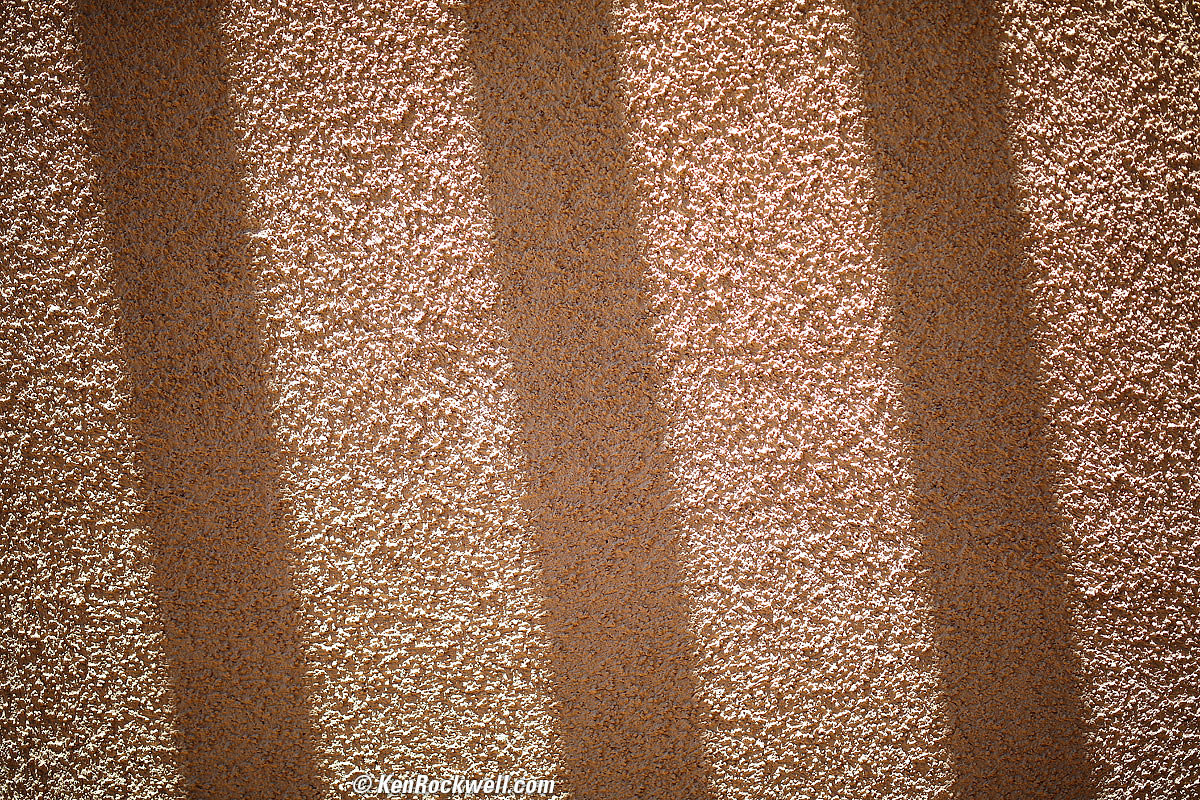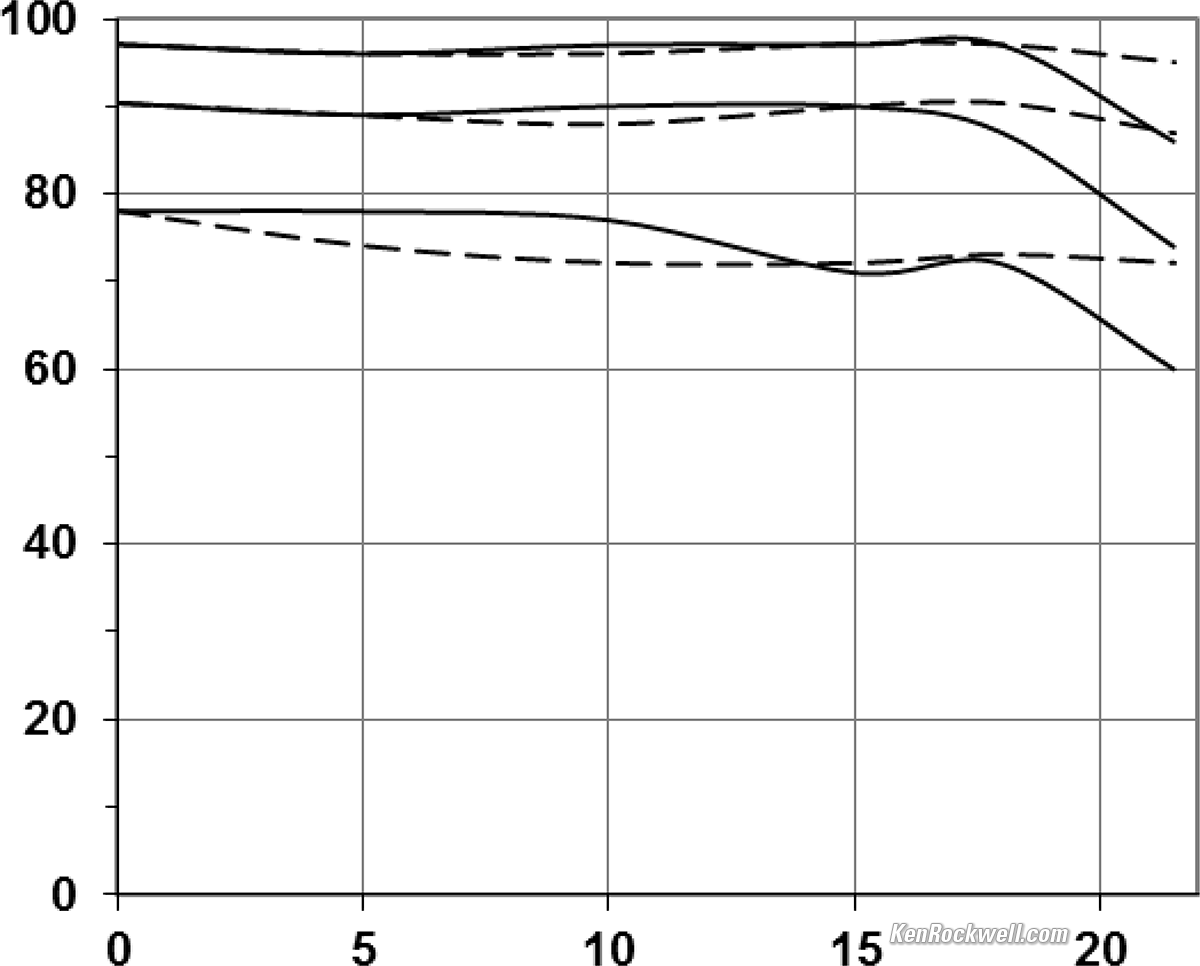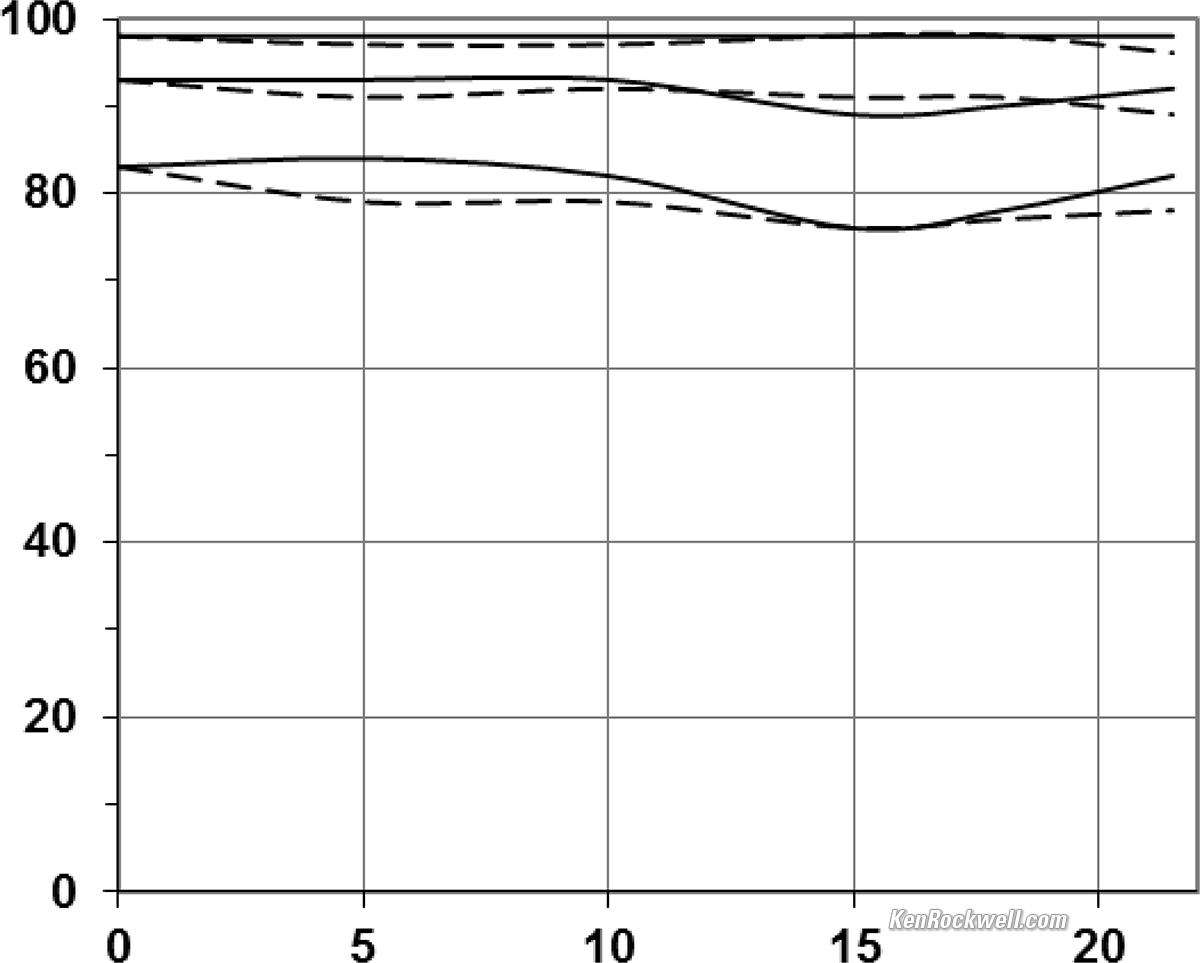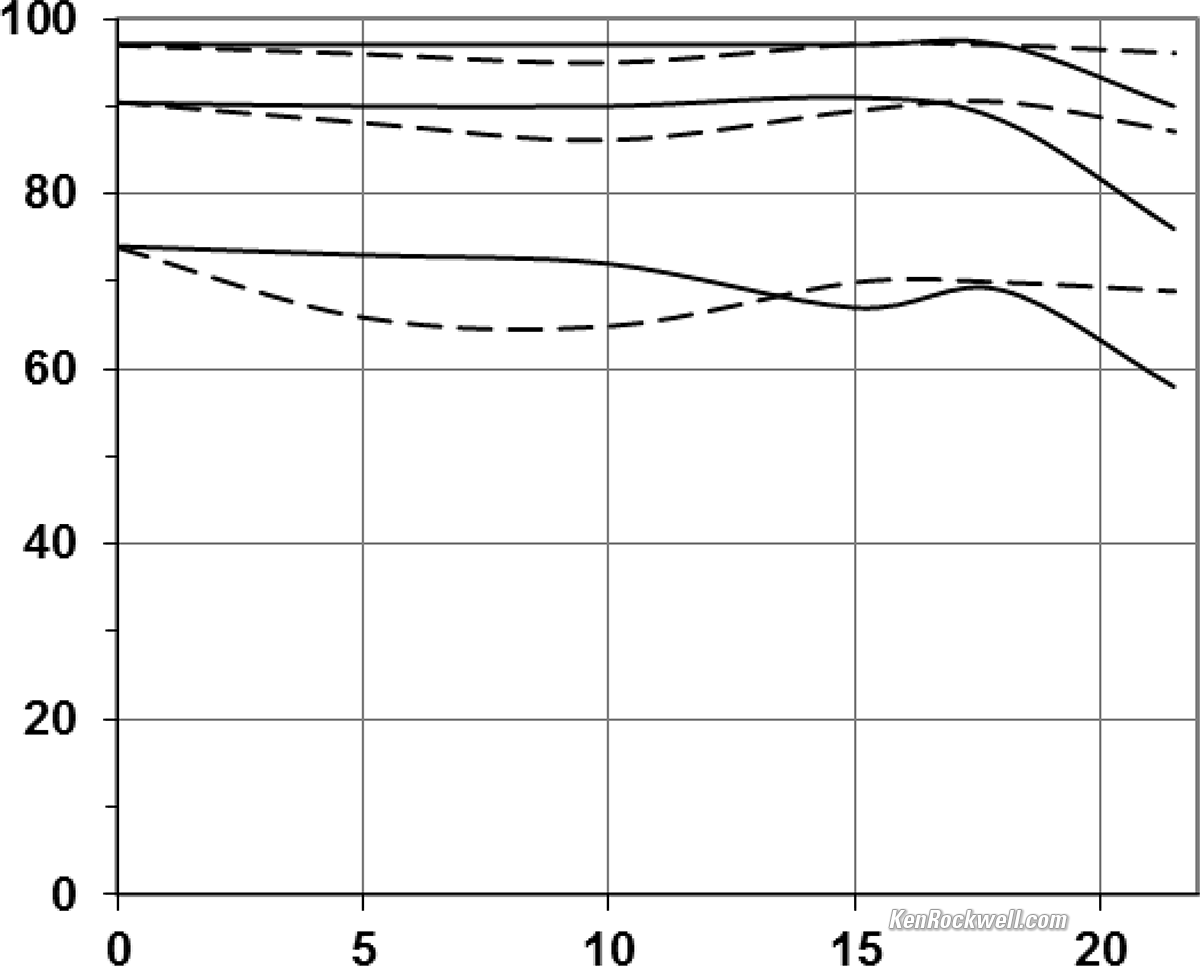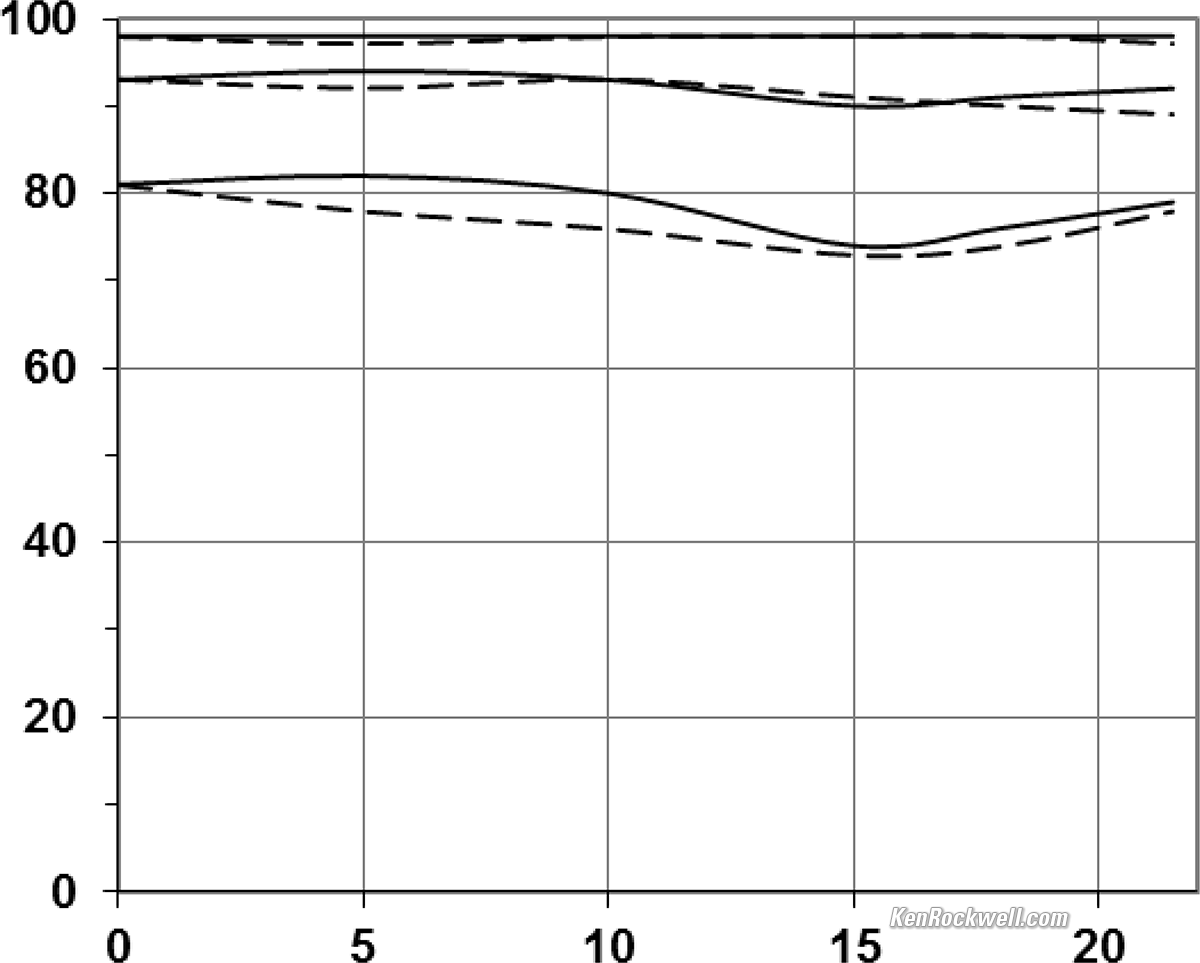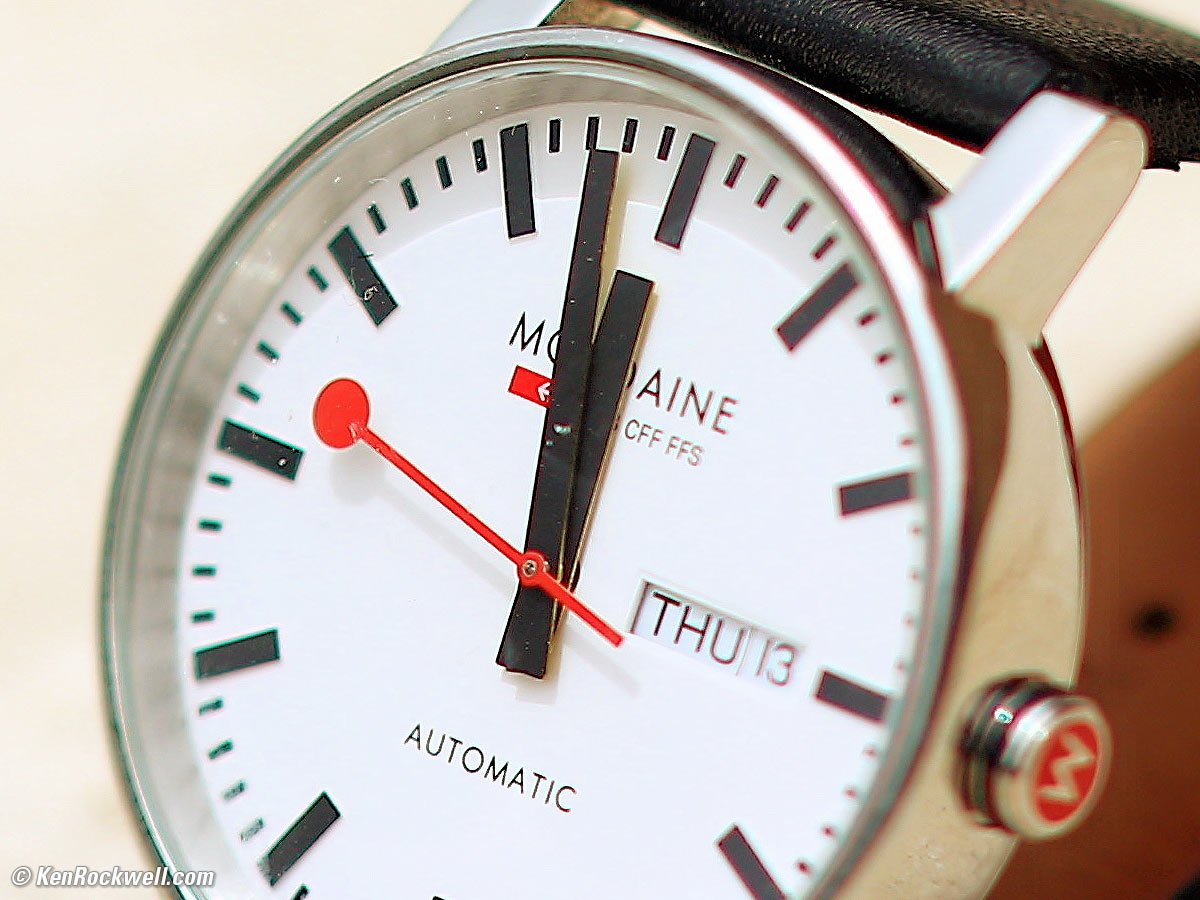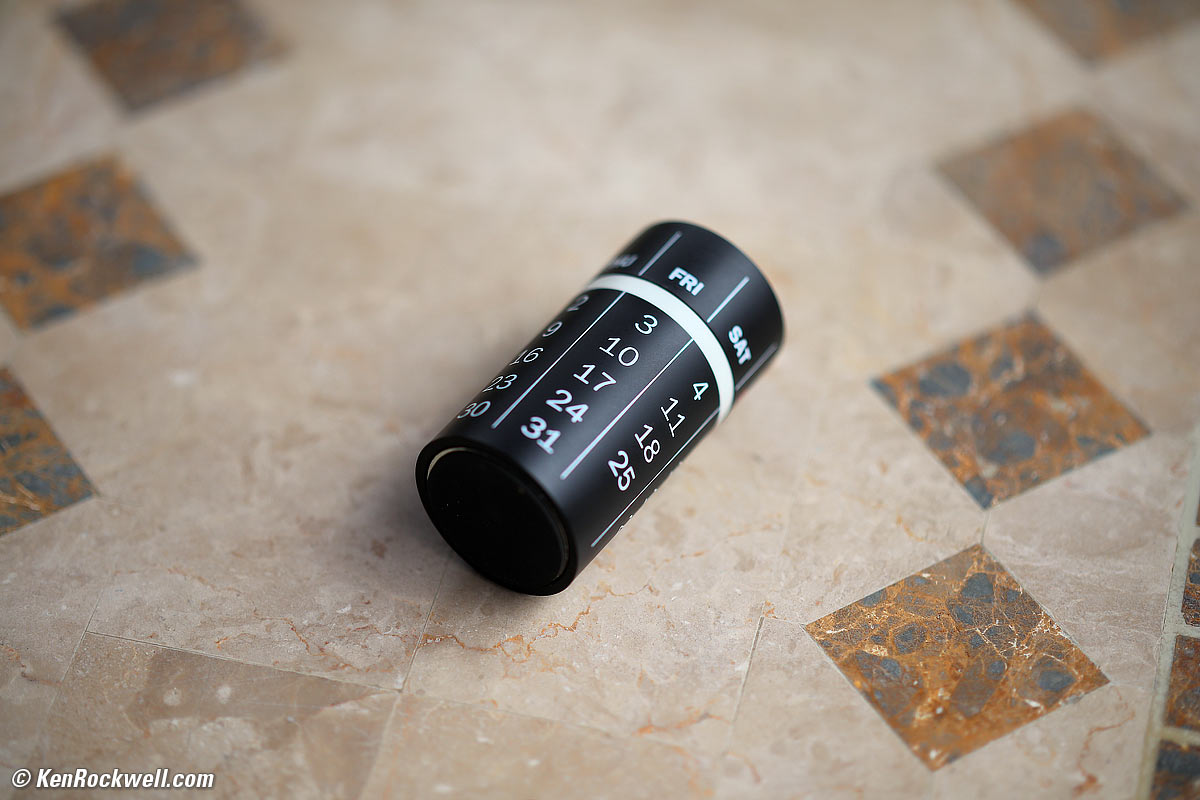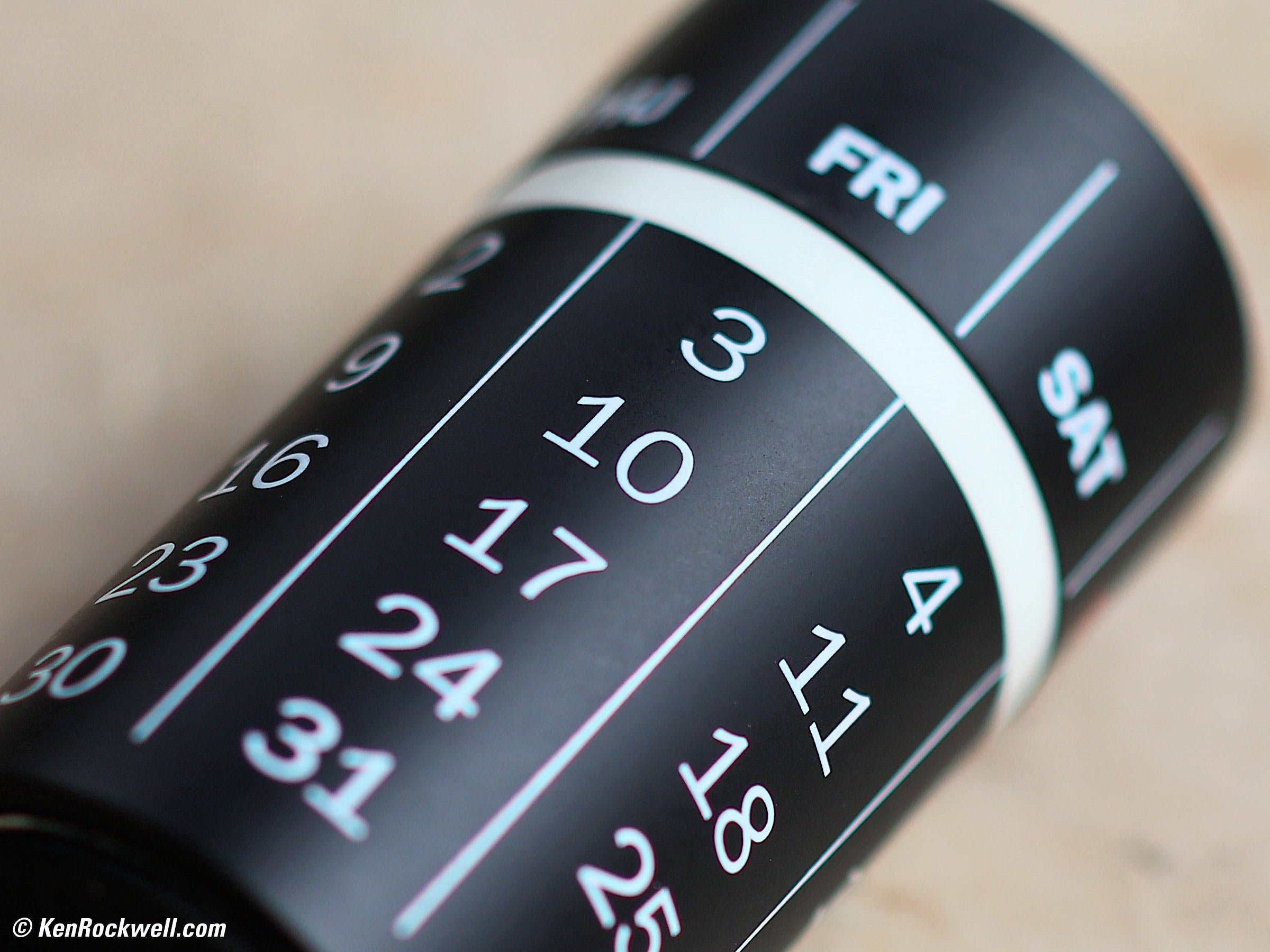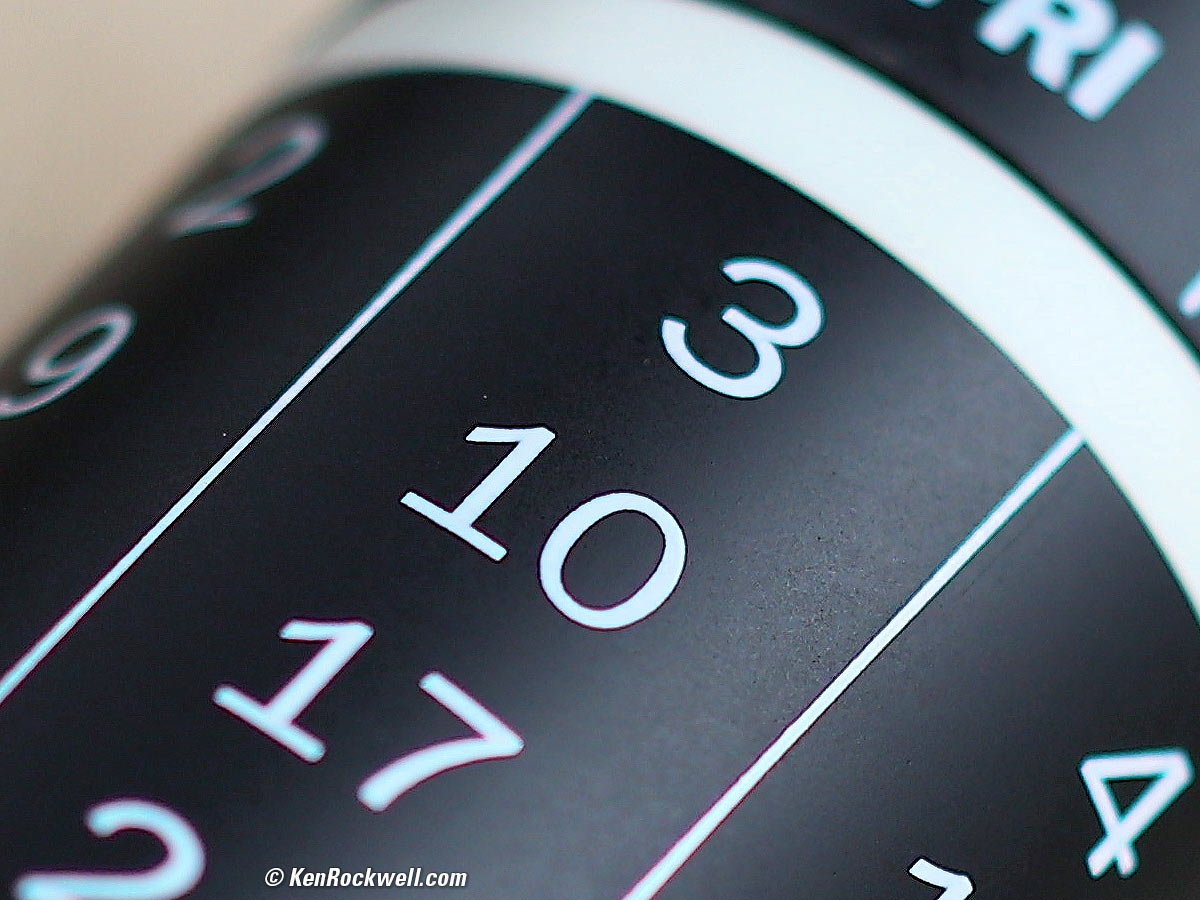Zeiss Otus 100mm f/1.4 T✻
Aspheric Manual-Focus for Canon & Nikon
Sample Images Intro Format Compatibility
Specifications Unboxing USA Version
Zeiss Otus T✻ 100mm f/1.4, Canon version, also comes for Nikon (metal 86mm filter thread, 47.6 oz. / 3 pounds / 1,349g, 3.3'/1m close focus, $4,990 new or get it at eBay (How to Win at eBay)). bigger.
I got my Canon version at B&H, who of course has the Nikon version. I'd also get either version at Adorama, either version at Amazon or get it at eBay (How to Win at eBay).
This all-content, junk-free website's biggest source of support is when you use those or any of these links to approved sources when you get anything, regardless of the country in which you live. Thanks for helping me help you! Ken.
June 2019 Better Pictures Zeiss Nikon Canon Sony Fuji LEICA All Review
Why Fixed Lenses Take Better Pictures
Sample Images
Top Sample Images Intro Format Compatibility
Specifications Unboxing USA Version
These are all shot hand-held as NORMAL JPGs; no RAW CR2 files or FINE JPGs or tripods were used or needed.
Three Palm Trunks, 10:12 AM 15 June 2019. Canon 5DS/R, Zeiss Otus 100mm f/1.4 at f/1.4 at 1/1,000 at Auto ISO 100, Perfectly Clear. bigger, full-resolution or camera-original © file.
I used this lens' strong light falloff at f/1.4 to emphasize the center tree. All three looked the same in person. Nothing is in focus here except for the center tree and a few blades of grass exactly in the thin plane of focus. Combine this lens' extreme sharpness on the center tree alone and the falloff's effect of highlighting this tree gives a three-dimensional effect.
Trek Émonda SLR 8 H2 58cm (Made in USA!!) at f/1.4, 17 June 2019, 11:09 AM. Canon 5DS/R, Zeiss Otus 100mm f/1.4 at f/1.4 at 1/6,400 at ISO 50, as shot. bigger or camera-original © file.
The camera-original © file on your computer at 100% shows us how the Zeiss Otus is much freer from color fringes on slightly out-of-focus highlights at f/1.4 than the Canon EF 85mm f/1.4L IS (see sample). Of course no one would shoot this at f/1.4, but you could if you want.
Also notice how the f/1.4 image is darker except in the center due to uncorrected light falloff. Cameras used to add extra exposure at full aperture to compensate for this, but in this case this Zeiss/Canon system is keeping the center exposure the same and letting the sides darken as we shoot at larger apertures.
Trek Émonda SLR 8 H2 58cm (Made in USA!!) at f/2.8, 17 June 2019, 11:09 AM. Canon 5DS/R, Zeiss Otus 100mm f/1.4 at f/2.8 at 1/1,600 at ISO 50, as shot. bigger or camera-original © file.
Trek Émonda SLR 8 H2 58cm (Made in USA!!) at f/5.6, 17 June 2019, 11:09 AM. Canon 5DS/R, Zeiss Otus 100mm f/1.4 at f/5.6 at 1/400 at ISO 50, as shot. bigger or camera-original © file.
The Zeiss Otus is so good that it's already diffraction-limited and getting softer at f/5.6; it's sharper back at f/2.8!
Desert Palms at 100º F, 17 June 2019, 2:48 PM. Canon 5DS/R, Zeiss Otus 100mm f/1.4 at f/1.4 at 1/4,000 at ISO 50, exactly as shot. bigger or camera-original © file.
Lookout: almost nothing is in focus at f/1.4. The falloff is obvious in this daylight shot, but no reasonable person shots at f/.4 in daylight. What the camera-original © file shows is how insanely sharp and contrasty is this lens wide-open at f/.4. Lenses never used to be this sharp at 1.4; they used to have much lower contrast.
Desert Palms at 100º F, 17 June 2019, 2:48 PM. Canon 5DS/R, Zeiss Otus 100mm f/1.4 at f/5.6 at 1/250 at ISO 50, exactly as shot. bigger or camera-original © file.
Introduction
Top Sample Images Intro Format Compatibility
Specifications Unboxing USA Version
|
I buy only from these approved sources. I can't vouch for ads below. |
This is an extraordinary lens for extraordinary people. It's the sharpest and best made 100mm lens available for sale legally to individuals and organizations outside of the law enforcement, space and defence communities. If you and your work demand and deserve nothing but the very, very best, this is your lens. You people know who you are: you demand and deserve the absolute best of everything. This isn't a lens for the masses.
While Zeiss and others have always known how to make a lens like this, they never did because conventional photography doesn't require this level of performance and this lens' ludicrous size, weight and expense made it prohibitive. Now that people use their iPhones for most things, Zeiss has to do something to keep selling lenses, like making lenses like this with levels of performance completely unnecessary for general photography — but your artistic expression goes far beyond mass-market general photography.
This behemoth three-pound manual-focus Zeiss lens offers astounding sharpness for people who shoot it at f/1.4, however sharpness is among a lens' least important virtues (all lenses are sharp when used properly). Neither Nikon nor Canon have a lens profile for this, so it always has some minor pincushion distortion at all apertures and strong light falloff at large apertures which cannot be corrected in-camera.
The talented artist who owns this lens will make use of falloff for his own artistic effect. This is a strength of this mighty lens as used by the immortals who choose it to share their superior powers of observation.
Autofocus never works with this lens; it is manual-focus only. Manual focus is super smooth.
This is a great lens for video shot on a follow-focus rig for its smooth, precise manual focus and great defocus effects with minimal spherochromatism (background color fringes).
Sharpness at f/1.4 is outstanding, however it's just as sharp as every other 100mm lens at moderate and smaller apertures — which are also ultrasharp.
So long as you can get precise manual infinity focus without a mechanical infinity stop, this is also a great lens for astronomy due to its extreme optical performance at f/1.4.
I got my Canon version at B&H, who of course has the Nikon version. I'd also get either version at Adorama, either version at Amazon or get it at eBay (How to Win at eBay).
Zeiss Otus 100mm f/1.4. bigger.
New
 Zeiss' first 100mm f/1.4 for consumers.
Zeiss' first 100mm f/1.4 for consumers.
Good
 Outstanding sharpness at f/1.4; just like the Canon EF 85mm f/1.4L IS and Nikon 105mm f/1.4.
Outstanding sharpness at f/1.4; just like the Canon EF 85mm f/1.4L IS and Nikon 105mm f/1.4.
 Minimal spherochromatism to reduces color fringes on slightly out-of-focus areas.
Minimal spherochromatism to reduces color fringes on slightly out-of-focus areas.
 All-metal construction.
All-metal construction.
 All markings deeply engraved and filled with paint, as every lens should be.
All markings deeply engraved and filled with paint, as every lens should be.
 Solid alloy hood included.
Solid alloy hood included.
 Unlike some non camera-brand lenses, the focus ring turns the correct way on Nikon and on Canon. Canon and Nikon turn in opposite directions, and many makers get lazy and make both versions turn the same way — which is the wrong way for one of the brands.
Unlike some non camera-brand lenses, the focus ring turns the correct way on Nikon and on Canon. Canon and Nikon turn in opposite directions, and many makers get lazy and make both versions turn the same way — which is the wrong way for one of the brands.
Bad
 Manual-focus only: autofocus NEVER works.
Manual-focus only: autofocus NEVER works.
 Offshored to Japan, NOT MADE IN GERMANY.
Offshored to Japan, NOT MADE IN GERMANY.
 Strong corner darkening (falloff) at f/1.4, which won't correct in-camera.
Strong corner darkening (falloff) at f/1.4, which won't correct in-camera.
 Minor pincushion distortion that won't correct in-camera.
Minor pincushion distortion that won't correct in-camera.
 No focus scale color-coding. Feet and meter scales are both yellow and get confused with each other.
No focus scale color-coding. Feet and meter scales are both yellow and get confused with each other.
 Wonderful included solid-alloy hood has an inside diameter too small to allow use with many 86mm filters.
Wonderful included solid-alloy hood has an inside diameter too small to allow use with many 86mm filters.
 Weighs three pounds, as much as a 70-200mm f/2.8!
Weighs three pounds, as much as a 70-200mm f/2.8!
 Costs $5,000.
Costs $5,000.
Missing
 No autofocus — ever.
No autofocus — ever.
 No focus scale color-coding. Feet and meter scales look the same and get confused with each other.
No focus scale color-coding. Feet and meter scales look the same and get confused with each other.
 Weighs as much as a 70-200mm f/2.8, but includes no tripod collar.
Weighs as much as a 70-200mm f/2.8, but includes no tripod collar.
 No in-camera corrections for anything, and it has minor distortion and strong light falloff at large apertures which would benefit from this.
No in-camera corrections for anything, and it has minor distortion and strong light falloff at large apertures which would benefit from this.
 Smooth rubber focus ring may look minimalist, but lacks ribs and thus lacks grip and is hard to find by feel — all very important for shooting a manual-focus only lens.
Smooth rubber focus ring may look minimalist, but lacks ribs and thus lacks grip and is hard to find by feel — all very important for shooting a manual-focus only lens.
 Only stops down to f/16, not f/22 or f/32.
Only stops down to f/16, not f/22 or f/32.
 No rubber bumpers on front of lens or hood.
No rubber bumpers on front of lens or hood.
 No case included.
No case included.
 Nikon version has a real aperture ring (good), but has no ADR (Aperture-Direct Readout) scale so there is no in-finder aperture readout on manual-focus Nikon 35mm cameras like the Nikon F2, F3, F4, F5, FE and FA. (Electronic finder readouts work fine on digital Nikons and the Nikon F6).
Nikon version has a real aperture ring (good), but has no ADR (Aperture-Direct Readout) scale so there is no in-finder aperture readout on manual-focus Nikon 35mm cameras like the Nikon F2, F3, F4, F5, FE and FA. (Electronic finder readouts work fine on digital Nikons and the Nikon F6).
Format
Top Sample Images Intro Format Compatibility
Specifications Unboxing USA Version
I got my Canon version at B&H, who of course has the Nikon version. I'd also get either version at Adorama, either version at Amazon or get it at eBay (How to Win at eBay).
This is a full frame lens and I'm reviewing it as such.
It also works great on APS-C cameras, on which you may make the usual inferences.
Compatibility
Top Sample Images Intro Format Compatibility
Specifications Unboxing USA Version
I got my Canon version at B&H, who of course has the Nikon version. I'd also get either version at Adorama, either version at Amazon or get it at eBay (How to Win at eBay).
Canon
This lens works flawlessly on every Canon DSLR and 35mm EOS SLR made since 1987 — except it has no autofocus.
It works flawlessly on every Canon full-frame and every Canon APS-C DSLR.
It also works flawlessly on every 35mm EOS camera, like my Canon EOS 1V, introduced in 2000, and yes, I tried it on my original 1987 Canon EOS 650 and focus indicators and the diaphragm work brilliantly.
Use an EF to RF adapter to use this on Canon's Full-Frame mirrorless cameras.
Use the EOS-M adapter to use this on Canon's EOS-M mirrorless cameras.
Nikon DSLR
Of course it won't autofocus on any camera, but it has a CPU so it offers full exposure automation, color matrix metering and EXIF data with all Nikon DSLRs.
Nikon Z Mirrorless
Use the FTZ adapter and it should work on Nikon's Z-series mirrorless cameras — except it has no autofocus.
Nikon 35mm SLR
It has a CPU so it offers full exposure automation, color matrix metering with all autofocus 35mm SLRs — but of course it only focuses manually.
As a manual-focus lens it works great with most Nikon manual-focus 35mm SLRs made since 1977. It has no coupling prong for the meters of pre-1977 cameras; you'll have to use stop-down metering or an external light meter instead.
Zeiss forgot the second ADR (Aperture-Direct Readout) scale on the aperture ring of the Nikon version, so no in-finder aperture readout on manual-focus Nikon 35mm cameras like the Nikon F2, F3, F4, F5, FE and FA. (Works fine on the Nikon F6).
Sony
Oddly there is no Sony version.
You could try the Canon EF Version and use the Metabones adapter, or just get real and use the superb Sony FE 85mm f/1.4 GM instead.
Specifications
Top Sample Images Intro Format Compatibility
Specifications Unboxing USA Version
I got my Canon version at B&H, who of course has the Nikon version. I'd also get either version at Adorama, either version at Amazon or get it at eBay (How to Win at eBay).
Name
Zeiss calls this the Zeiss T✻ Otus Apo Sonnar 1.4/100 ZE or ZF.2.
T✻: Zeiss' trademark for their multicoating. Looks cool in print, but no different than any other coatings.
Otus: obscure Latin reference to owls. Kodak already uses the trademark "Hawkeye" so Zeiss was out of luck.
Apo: Apochromatic; supposedly corrected for three rather than two colors.
Sonnar: Zeiss' ancient trademark for many of its longer lenses.
ZE: for Canon (Zeiss ~ EOS EF).
ZF: for Nikon (Zeiss ~ F-mount).
.2: Nikon CPU contacts.
Optics
Zeiss Otus 100/1.4 internal optical construction. Glass, ED glass and Aspherical elements. bigger.
(Zeiss included the lens hood in this diagram.)
14 elements in 11 groups.
8 ED extra-low dispersion elements (a.k.a. anomalous partial dispersion elements) which help reduce secondary chromatic aberration.
1 aspherical element.
T✻ multicoating.
Filters
Metal 86mm filter thread with standard (coarse) 1.0mm thread pitch.
Coverage
Canon: Full-Frame, 35mm and APS-C.
Diaphragm
Zeiss Otus 100/1.4 at f/1.4 (diaphragm not shown). bigger.
9 blades.
Stops down to f/16 in 1/3-stop clicks.
Focal Length
100mm.
When used on Nikon DX cameras, it sees the same angle of view as a 150 mm lens sees when used on an FX or 35mm camera.
When used on Canon's APS-C cameras, it sees the same angle of view as a 160 mm lens sees when used on a full-frame or 35mm camera.
See also Crop Factor.
Angle of View, Full-Frame
24º diagonal.
20º horizontal.
14º vertical.
Focus Scale
Yes.
315º rotation.
Infinity Focus Stop
No.
Depth of Field Scale
Yes.
Infrared Focus Index
Yes, red line in the depth-of-field scale.
Close Focus
3.3 feet (1 meter).
Maximum Reproduction Ratio
1:8.6 (0.12×).
Minimum Subject Field
8.11 x 12.17 inches.
206 × 309 mm.
Reproduction Ratio Scale
No.
Image Stabilizer
NONE.
Hood
Included solid alloy bayonet hood. bigger. |
Bottom, solid alloy hood. bigger. |
The solid alloy bayonet hood is included.
It's $300 for a spare.
It's solid, however the bayonet receiver (mounting) section is only plastic.
It reverses.
The bad news is that the inner diameter of the hood is very small, so small that many filters (like the one I use) are just a fraction of a millimeter too big so that the hood can't mount over them — so I don't use the hood.
Case
None included.
Tripod Collar
None.
Size
Canon
3.96" Ø maximum diameter × 5.07" overall length.
101 mm Ø maximum diameter × 129 mm overall length.
Nikon
3.96" Ø maximum diameter × 4.98" overall length.
101 mm Ø maximum diameter × 127 mm overall length.
Weight
Canon
47.580 oz. (2.97 pounds or 1,348.9 grams) actual measured weight.
Rated 49.56 oz. (3.10 pounds or 1,405 grams).
Nikon
Rated 47.12 oz. (2.95 pounds or 1,336 grams).
Quality
Made in Japan.
Announced
24 April 2019.
Included
Lens.
Zeiss' own 86mm front and rear caps.
Warranty card, users manual and paperwork.
Zeiss' Model Numbers
Canon
2233-404
Nikon
2233-403
Price, USA
$4,990, April ~ June 2019.
Unboxing
Top Sample Images Intro Format Compatibility
Specifications Unboxing USA Version
I got my Canon version at B&H, who of course has the Nikon version. I'd also get either version at Adorama, either version at Amazon or get it at eBay (How to Win at eBay).
The box and lens are completely unsealed. There is no way to know if anyone else has been fiddling with your exotic $5,000 lens, swapping parts and accessories, or even if it's a used or dropped lens.
Only to buy yours from an approved online source, since they ship from automated warehouses where no salesmen or other customers ever get to touch your new lens before it ships. While new $5 CDs, DVDs, Blu-Rays and bottles of milk and drinking water are sealed and quite obvious if anyone's opened them, paradoxically Zeiss doesn't bother sealing anything, so your only insurance is to buy only from a trusted online dealer. With an exotic lens like this, making the mistake of buying at retail pretty much guarantees that what you think is a new lens has been taken out and tried many, many times before you pay full price for it. Never buy at retail, only get yours from my personally approved online sources.
There's an outer cardboard sleeve with a holographic CARL ZEISS AG "Exclusively for AMERICAS" sticker:
Box in outer germ-resistant sleeve. bigger.
The sleeve has "Otus 1.4/100 ZE (or ZF.2) mount" hot-stamped in reflective silver on the front lower left, which will look whatever color it reflects; it looks white or disappears in gray in the photo above. It's easy to read when you hold the box moving around in your hands.
On the bottom of the sleeve (not shown here) are bar codes for the EAN, JAN, model number and UPC codes, and a sticker with a bar code and the lens' serial number.
Remove the sleeve and you have this box inside:
Inner box without sleeve. bigger.
Open the cover and you have:
Inside the box. Left to right: small white box with paperwork, hood and lens. bigger.
Pull out the small box and the paperwork contained inside is:
Included paperwork: 3-Year warranty, Test Certificate and Instructions. bigger.
Getting a Legal USA Version
Top Sample Images Intro Format Compatibility
Specifications Unboxing USA Version
I got my Canon version at B&H, who of course has the Nikon version. I'd also get either version at Adorama, either version at Amazon or get it at eBay (How to Win at eBay).
This section applies in the USA only.
In the USA, be sure your box has a holographic "Exclusively for AMERICAS" sticker on the outer white cardboard sleeve as shown above, and that the serial number on the sticker on this sleeve matches the one on the bottom of your lens and the one on the Test Certificate.
If you don't have this AMERICAS sticker or any of the serial numbers don't match, you got ripped off with a gray market version from another country. This is why I never buy anyplace other than from my personally approved sources. You just can't take the chance of buying elsewhere, especially at any retail store, because non-USA versions have no warranty in the USA, and you won't even be able to or service for it — even if you're willing to pay out-of-pocket for it when you need it
If a gray market version saves you $1,000 it may be worth it to take a chance as I doubt this lens will need service for at least 40 years, but for $200 or less I wouldn't risk having no warranty or support.
Always be sure to check yours while you can still return it, or just don't buy from unapproved sources and never buy at retail so you'll be able to have your camera serviced as needed.
Performance
Top Sample Images Intro Format Compatibility
Specifications Unboxing USA Version
Overall Autofocus Focus Breathing Bokeh
Distortion Ergonomics Exposure Falloff
Filters Flare & Ghosts Lateral Color Fringes
Lens Corrections Macro Mechanics
Sharpness Spherochromatism Stabilization
I got my Canon version at B&H, who of course has the Nikon version. I'd also get either version at Adorama, either version at Amazon or get it at eBay (How to Win at eBay).
Overall
This 100mm f/1.4 is a whopper, and offers extreme sharpness and clarity at f/1.4 we expect for $5,000.
Autofocus
There is NO autofocus.
Focus
Focus is smooth, liquid and precise. It's not fast; you have to turn the ring 315º to get from infinity down to 3.3'/1m.
The smooth rubber covering looks nice, but lacks the grip of a ribbed focus ring.
Focus Breathing
Focus breathing is the image changing size as focused in and out. It's important to cinematographers that the image not breathe because it looks funny if the image changes size as focus gets pulled back and forth between actors. If the lens does this, the image "breathes" by growing and contracting slightly as the dialog goes back and forth.
The image from the Zeiss 100/1.4 gets a little larger as focused more closely.
Bokeh
Bokeh, the feel, character or quality of out-of-focus areas as opposed to how far out of focus they are, is neutral. While the background will get way out of focus at f/1.4, the actual character of this defocus isn't particularly soft; the edges of blur circles are sharper than we'd like them which can lead to business and false resolution in out-of-focus areas.
Here are photos from headshot distance. Click any for the camera-original © files:
Davis 6250 weather station, 14 June 2019. Click any for the camera-original © files.
These also show how insanely sharp this lens is at f/1.4: look at the DAVIS logo in the f/1.4 camera-original file at 100% and it's astounding how sharp, contrasty, clear and completely devoid of color fringes it is. This is superior to all similar lenses like the Canon EF 85mm f/1.4L IS and Canon EF 100mm f/2 USM and Sony 85mm f/1.4 GM. The Nikon 105mm f/1.4 is as good.
As always, if you want to throw the background as far out of focus as possible, shoot at f/1.4 and get as close as possible.
Distortion
The Zeiss 100 1.4 has about the same level of minor pincushion distortion as the Nikon 105mm f/1.4 and Canon EF 85mm f/1.4L IS, however the distortion of the Nikon and Canon brand lenses will be corrected automatically in-camera while the distortion from this Zeiss lens will not.
The Canon EF 100mm f/2 USM has less distortion while the Sony FE 85mm f/1.4 GM has nearly none, and most 100mm macro lenses have no distortion.
Using these factors in Photoshop's lens correction filter to remove this distortion. These aren't facts or specifications, they are the results of my research that requires hours of photography and calculations on the resulting data.
Distance |
Correction factor on full-frame |
100' (30m) |
-0.90 |
30' (10m) |
-1.20 |
10' (3m) |
-0.70 |
3' (1m) |
-0.40 |
© 2019 KenRockwell.com. All rights reserved.
Here's Zeiss' distortion curve at infinity:
Zeiss Otus 100mm f/1.4 distortion at infinity.
Ergonomics
Zeiss Otus 100mm f/1.4. bigger.
This is a huge, heavy lens. Normal people would balk at something so ridiculous, but normal people don't buy lenses like this.
The focus ring turns wonderfully smoothly, but sadly lacks ribs so it's both hard to find the focus ring by feel and requires extra finger pressure to keep your grip. In this case style trumped utility.
The focus scales are large and well engraved, but sadly everything is in the same color. Feet and meters look the same. Zeiss tried to save a few dollars and reduced this lens' utility; everything should be white and only feet should be in yellow.
Infra-red focus index, focus & depth-of-field scales. bigger.
The inner diameter of the hood is very small, so small that many filters (like the one I use) are just a fraction of a millimeter too big so that the hood can't mount over them — so I don't use the hood. You have to choose to use the hood or a filter, but often not both.
There is no way to rotate a grad or polarizer when the hood is attached.
The focus ring rotates the correct way for Canon and for Nikon.
Exposure
Falloff at f/1.4 can make images shot at f/1.4 seem darker. You can add exposure compensation at the risk of overexposing the center of the image.
Falloff
Falloff is strong at f/1.4 and moderate at f/2, and will not correct in-camera as it does with camera-brand lenses. See Sample Images and Macro for more examples.
Falloff is gone by f/2.8.
I've exaggerated the falloff by shooting a gray field and placing these on a gray background; it will not look this bad in actual photos of real things:
Otus 100mm f/1.4 falloff at infinity, no correction available.
© 2019 KenRockwell.com. All rights reserved. |
Here are Zeiss' falloff curves at infinity, which clearly show 2⅓ stops of falloff at f/1.4:
Zeiss Otus 100mm f/1.4 falloff at infinity.
Filters, use with
There's no need for thin filters.
Go ahead and use your standard rotating polarizer and grad filters and stack them if you like.
The inner diameter of the hood is very small, so small that many filters (like the one I use) are just a fraction of a millimeter too big so that the hood can't mount over them — so I don't use the hood. You have to choose to use the hood or a filter, but often not both.
There is no way to rotate a grad or polarizer when the hood is attached.
Flare & Ghosts
Even though this is a very complex lens, flare and ghosts are minimal. You'll have to work very hard to get it to flare.
Lateral Color Fringes
There are no lateral color fringes.
There is a little spherochromatism, which can cause color fringes on things that aren't in perfect focus. Spherochromatism is a completely different aberration in a different dimension than lateral color fringes.
Lens Corrections
Since there is no lens profile, neither Nikon nor Canon can correct anything. If you're looking you will see darker corners at f/1.4 and minor pincushion distortion.
Nikons made since 2007 correct all lenses for lateral color, but this this is so good there isn't any anyway.
Macro Performance
Don't use this for macro, use a real 100mm macro lens which costs much less and works much better.
This lens doesn't get very close, and there's very little use for f/1.4 at macro distances because nothing is in focus. In this snap at the close-focus distance only a small bit of the hibiscus' stamen and stigma are in focus and all else is lost:
Hibiscus, 10:13 AM 15 June 2019. Canon 5DS/R, Zeiss Otus 100mm f/1.4 at f/1.4 at 1/1,000 at Auto ISO 100, exactly as shot. bigger or camera-original © file.
1,200 × 900 pixel crop from above. bigger or camera-original © file.
While it doesn't get very close, its sharpness and clarity wide-open at f/1.4 is stunning. No other 100mm or 85mm lens is this sharp at f/1.4 at these distances:
Mondaine A132.30348.11SBB at close-focus distance at f/1.4, 13 June 2019. bigger or camera-original © file.
1,200 × 900 pixel crop from above. bigger or camera-original © file.
If this 1,200 × 900 pixel crop is about 3" (7.5cm) wide on your screen, then the complete image printed at this same large magnification would be about 15 × 22" (1.2 × 1.8 feet or 38 × 55 cm).
If this 1,200 × 900 pixel crop is about 6" (15cm) wide on your screen, then the complete image printed at this same extreme magnification would be about 29 × 43" (2.4 × 3.6 feet or 0.75 × 1.1 meters).
If this 1,200 × 900 pixel crop is about 12" (30cm) wide on your screen, then the complete image printed at this same insanely high magnification would be about 58 × 87" (4.8 × 7.2 feet or 1.5 × 2.2 meters).
Mechanical Quality
Zeiss Otus 100mm f/1.4. bigger.
This is an all-metal lens made as it should be. It's sad that we have to spend $5,000 just to get an all-metal lens today that won't even autofocus and it's made in Japan.
Finish
Black anodized alloy.
Hood
Solid alloy with fuzz on the inside but plastic at the bayonet mount.
No bumper.
Front Bumper
None.
Filter Threads
Metal.
Hood Bayonet Mount
Metal.
Barrels
Metal.
Focus Ring
Rubber-covered metal.
Tripod Collar
None.
Identity & Serial Number
Identity engraved and filled with paint on metal ring between front element and filter threads:
Zeiss Otus 100/1.4 T✻. bigger.
Also deeply engraved and filled with paint on bottom of barrel:
Bottom. bigger.
Internals
Seem like all metal!
Dust Gasket at Mount
No.
Mount
Dull chromed metal.
Markings
All engraved and filled with paint.
Date Code
None found.
Noises When Shaken
Very mild clicking from the diaphragm blades.
Made in
Japan.
Sharpness
Lens sharpness has nothing to do with picture sharpness; every lens made in the past 100 years is more than sharp enough to make super-sharp pictures if you know what you're doing. The only limitation to picture sharpness is your skill as a photographer. It's the least talented who spend the most time worrying about lens sharpness and blame crummy pictures on their equipment rather than themselves. Skilled photographers make great images with whatever camera is in their hands; I've made some of my best images of all time with an irreparably broken camera! Most pixels are thrown away before you see them, but lens makers don't want you to know that.
If you're not getting ultra-sharp pictures with this, be sure not to shoot at f/11 or smaller where all lenses are softer due to diffraction, always shoot at ISO 100 or below because cameras become softer at ISO 200 and above, avoid shooting across long distances over land which can lead to atmospheric heat shimmer, be sure everything is in perfect focus, and be sure nothing is moving, either camera or subject. If you want to ensure a soft image with any lens, shoot at f/16 at ISO 1,600 in daylight through heat shimmer of rapidly moving subjects at differing distances in the same image.
This lens is completely sharp even at f/1.4 all the way to the corners.
Here's a boring sample shot wide-open at f/1.4 whose full-resolution file should show you how insanely sharp this lens can be wide open at f/1.4 from center to corner, where more other lenses are soft and loaded with spherochromatic color fringes.
Tree, 11:19 AM 15 June 2019. Canon 5DS/R, Zeiss Otus 100mm f/1.4 at f/1.4 at 1/6,400 at Auto ISO 100, Perfectly Clear. bigger, full-resolution or camera-original © file.
Of course very little is in focus at f/1.4, but what is in focus is perfectly sharp, clear and contrasty like almost no other lens at f/1.4, and spherochromatic color fringes on out-of focus ares are also nearly nonexistent. This is exemplary performance.
Here's the same thing stopped down to f/4, where all lenses are about this sharp and a little more is in focus:
Tree, 11:19 AM 15 June 2019. Canon 5DS/R, Zeiss Otus 100mm f/1.4 at f/4 at 1/800 at Auto ISO 100, Perfectly Clear. bigger, full-resolution or camera-original © file.
Wall of Shame, 12:35 PM ,14 June 2019. Canon 5DS/R, Zeiss Otus 100mm f/1.4 at f/1.4 at 1/800 at ISO 50, as shot. bigger or camera-original © file.
For those of you who prefer the Wall of Shame, look at the camera-original © file at 100% and look in the corners. Yes, they're darker, but just as insanely sharp as the center. This is amazing performance.
Here are Zeiss' Otus 100/1.4 measured white-light MTF charts at 10, 20 and 40 cycles per millimeter, sagittal and tangential, which confirm what I'm seeing. These show that this lens is diffraction-limited by f/5.6, and doesn't get softer at larger apertures.
MTF at f/1.4 at infinity. |
MTF at f/4 at infinity. |
MTF at f/1.4 at 7 feet (2.1 meters or 1:20). |
MTF at f/4 at 7 feet (2.1 meters or 1:20). |
Spherochromatism
Spherochromatism, also called "color bokeh" by laymen, is an advanced form of chromatic aberration in a different dimension than lateral color. It can cause colored fringes on out-of-focus highlights, usually seen as green fringes on backgrounds and magenta fringes on foregrounds. Spherochromatism is common in fast lenses of moderate focal length when shooting contrasty items at full aperture. It goes away as stopped down.
Fast, short telephotos usually have loads of spherochromatism, while this lens has nearly none. This means that the magenta and green fringes so often seen on slightly out-of-focus areas with other lenses will have much less, or no, fringes with this lens.
Mondaine A132.30348.11SBB at close-focus distance at f/1.4, 13 June 2019. bigger or camera-original © file.
1,200 × 900 pixel crop from above. bigger or camera-original © file.
If this 1,200 × 900 pixel crop is about 3" (7.5cm) wide on your screen, then the complete image printed at this same large magnification would be about 15 × 22" (1.2 × 1.8 feet or 38 × 55 cm).
If this 1,200 × 900 pixel crop is about 6" (15cm) wide on your screen, then the complete image printed at this same extreme magnification would be about 29 × 43" (2.4 × 3.6 feet or 0.75 × 1.1 meters).
If this 1,200 × 900 pixel crop is about 12" (30cm) wide on your screen, then the complete image printed at this same insanely high magnification would be about 58 × 87" (4.8 × 7.2 feet or 1.5 × 2.2 meters).
At close-focus distance at f/1.4, 15 June 2019. bigger or camera-original © file.
2,400 × 1,800 pixel crop from above. bigger or camera-original © file.
If this 2,400 × 1,800 pixel crop is about 3" (7.5cm) wide on your screen, then the complete image printed at this same large magnification would be about 7.5 × 11" (19 × 28 cm).
If this 2,400 × 1,800 pixel crop is about 6" (15cm) wide on your screen, then the complete image printed at this same extreme magnification would be about 15 × 22" (1.2 × 1.8 feet or 38 × 55 cm).
If this 2,400 × 1,800 pixel crop is about 12" (30cm) wide on your screen, then the complete image printed at this same insanely high magnification would be about 29 × 43" (2.4 × 3.6 feet or 0.75 × 1.1 meters).
1,200 × 900 pixel crop from above. bigger or camera-original © file.
If this 1,200 × 900 pixel crop is about 3" (7.5cm) wide on your screen, then the complete image printed at this same large magnification would be about 15 × 22" (1.2 × 1.8 feet or 38 × 55 cm).
If this 1,200 × 900 pixel crop is about 6" (15cm) wide on your screen, then the complete image printed at this same extreme magnification would be about 29 × 43" (2.4 × 3.6 feet or 0.75 × 1.1 meters).
If this 1,200 × 900 pixel crop is about 12" (30cm) wide on your screen, then the complete image printed at this same insanely high magnification would be about 58 × 87" (4.8 × 7.2 feet or 1.5 × 2.2 meters).
You also can look at the samples at Bokeh and look at the DAVIS logo in the f/1.4 camera-original file at 100%. It's astounding how sharp, contrasty, clear and completely devoid of color fringes it is. This is superior to all similar lenses like the Canon EF 85mm f/1.4L IS and Canon EF 100mm f/2 USM and Sony 85mm f/1.4 GM. The Nikon 105mm f/1.4 is as good.
You can also see this in the full-resolution tree image at Sharpness.
Image Stabilization
This Zeiss has no Optical Image Stabilization (OIS, IS or VR (Vibration Reduction)).
Sunstars
I can't get much in the way of sunstars on brilliant points of light.
Tripod Collar
There is no tripod collar, but this is a beast of a lens and even my big Canon 5DS/R feels rather unbalanced supporting the whole rig from the Canon 5DS/R's own tripod socket.
Compared
Top Sample Images Intro Format Compatibility
Specifications Unboxing USA Version
I got my Canon version at B&H, who of course has the Nikon version. I'd also get either version at Adorama, either version at Amazon or get it at eBay (How to Win at eBay).
This Zeiss Otus is by far the biggest, heaviest and most expensive, and it's the sharpest by an invisible margin wide-open, but its distortion and falloff cannot be corrected in-camera as with the other lenses, potentially giving visibly inferior images. We can see falloff and rarely distortion in normal size prints, but due to pixel dumping any potential or imaginary sharpness advantage will only be visible seen on a computer at 100% in a laboratory, not in actual photos.
See also my comparisons throughout the review.
| AF? | NO |
YES |
YES |
YES |
YES |
| IS/VR? | NO |
NO |
YES |
NO |
NO |
| Filter size | 86mm |
82mm |
77mm |
58mm |
77mm |
| Filter threads | Metal |
Plastic |
Plastic |
Metal |
Plastic |
| Close focus | 3.3' 1m |
3.3' 1m |
2.8' 0.85m |
3' 0.9m |
2.7' 0.85m |
| Macro | 1:8.6 |
1:7.7 |
1:8.3 |
1:7.1 |
1:8.3 |
| Diaphragm | 9 blades |
9 blades |
9 blades |
8 blades |
11 blades |
| Weight | 47.6 oz 1,349g |
34.8 oz. 985g |
33.2 oz. 941g |
14.7 oz 417g |
28.9 oz. 820g |
| Sharpness | Excellent |
Excellent |
Excellent |
Excellent |
Excellent |
| Sharpness, wide open in the corners | Excellent |
Excellent |
Excellent |
Very Good |
Excellent |
Distortion |
|||||
| Distortion correction?* | NO |
YES |
YES |
YES |
YES |
| Falloff wide-open | |||||
| Falloff correction?* | NO |
YES |
YES |
YES |
YES |
| Spherochromatic aberration** | |||||
| Quality | Japan |
China |
Japan |
Japan |
Japan |
| Price, 6/2019 |
* In most newer cameras.
** You also can look at the samples at Bokeh and look at the DAVIS logo in the f/1.4 camera-original file at 100%. It's astounding how sharp, contrasty, clear and completely devoid of color fringes it is. This is superior to all similar lenses like the Canon EF 85mm f/1.4L IS and Canon EF 100mm f/2 USM and Sony 85mm f/1.4 GM. The Nikon 105mm f/1.4 is as good.
User's Guide
Top Sample Images Intro Format Compatibility
Specifications Unboxing USA Version
I got my Canon version at B&H, who of course has the Nikon version. I'd also get either version at Adorama, either version at Amazon or get it at eBay (How to Win at eBay).
This is a huge lens. I use two hands to try not to drop it.
Be sure to attach filters before attaching the hood (if you use it) because many filters are too big for the hood to mount over them.
Magnified Live View gives the most accurate and precise focus, however I pleasantly discovered that my Canon 5DS/R's single green in-finder focus confirmation dot actually gives great results even at f/1.4. You have to hold the shutter halfway down for it to indicate.
For best results at large apertures at portrait and closer distances you should use a tripod because just breathing you'll move back and forth enough to lose perfect focus, and thus lose the performance for which you're paying a premium.
Recommendations
Top Sample Images Intro Format Compatibility
Specifications Unboxing USA Version
I got my Canon version at B&H, who of course has the Nikon version. I'd also get either version at Adorama, either version at Amazon or get it at eBay (How to Win at eBay).
If you and your work demand only the very sharpest optics at large apertures there is no better lens. You will however have to focus manually and you will have falloff at f/1.4 that doesn't correct in-camera.
If you're not shooting at f/1.4 or very large apertures, you're not going to see the optical benefits of this lens. Any other 100mm lens will have the same optical quality stopped down.
This is a lens for the world's most visionary artists. If you have to ask Is It Worth It, this lens might not be for you. The Nikon 105/1.4 has the same overall optical quality with correctable falloff and distortion and adds autofocus for one third the price, albeit made cheaply in China out of plastic. The Canon 85/1.4L IS also offers the same optical quality with more spherochromatism for less than one-third the price, with correctable falloff and distortion, and adds autofocus and IS/VR and is also made in Japan like this Zeiss.
I use a clear (UV) protective filter instead of a cap so I'm always ready to shoot instantly. I only use a cap when I throw this in a bag with other gear without padding — which is never. The UV filter never gets in the way, and never gets lost, either.
The B+W 86mm UV Haze MRC 010M Filter as the best combination of price, performance and MADE-IN-GERMANY quality befitting this fine lens. Of course if you deserve this lens you deserve the Zeiss T* 86mm UV. I use the Hoya 86mm HMC UV Filter because I already have one (filters last forever). Unfortunately Hoya doesn't make their superior hardened-glass HD filters in 86mm.
I got my Canon version at B&H, who of course has the Nikon version. I'd also get either version at Adorama or either at Amazon.
This 100% all-content website's biggest source of support is when you use those or any of these links to approved sources when you get anything, regardless of the country in which you live. Zeiss does not seal its boxes in any way, so never buy at retail or any other source not on my personally approved list since you'll have no way of knowing if it's been dropped, you're missing accessories, getting a defective, damaged, returned, non-USA, store demo or used lens. I use the stores I do because they ship from secure remote warehouses where no one gets to touch your new lens before you do. Especially with an exotic like this, you have to buy only from the approved sources I use myself to ensure that your neighborhood dealer hasn't been letting everyone play with this before you bought it. I use my approved sources for the best prices, service, return policies and selection.
Thanks for helping me help you!
Ken, Mrs. Rockwell, Ryan and Katie.
© Ken Rockwell. All rights reserved. Tous droits réservés. Alle Rechte vorbehalten.
Help Me Help You
I support my growing family through this website, as crazy as it might seem.
The biggest help is when you use any of these links when you get anything. It costs you nothing, and is this site's, and thus my family's, biggest source of support. These places always have the best prices and service, which is why I've used them since before this website existed. I recommend them all personally.
If you find this page as helpful as a book you might have had to buy or a workshop you may have had to take, feel free to help me continue helping everyone.
If you've gotten your gear through one of my links or helped otherwise, you're family. It's great people like you who allow me to keep adding to this site full-time. Thanks!
If you haven't helped yet, please do, and consider helping me with a gift of $5.00.
As this page is copyrighted and formally registered, it is unlawful to make copies, especially in the form of printouts for personal use. If you wish to make a printout for personal use, you are granted one-time permission only if you PayPal me $5.00 per printout or part thereof. Thank you!
Thanks for reading!
Mr. & Mrs. Ken Rockwell, Ryan and Katie.
